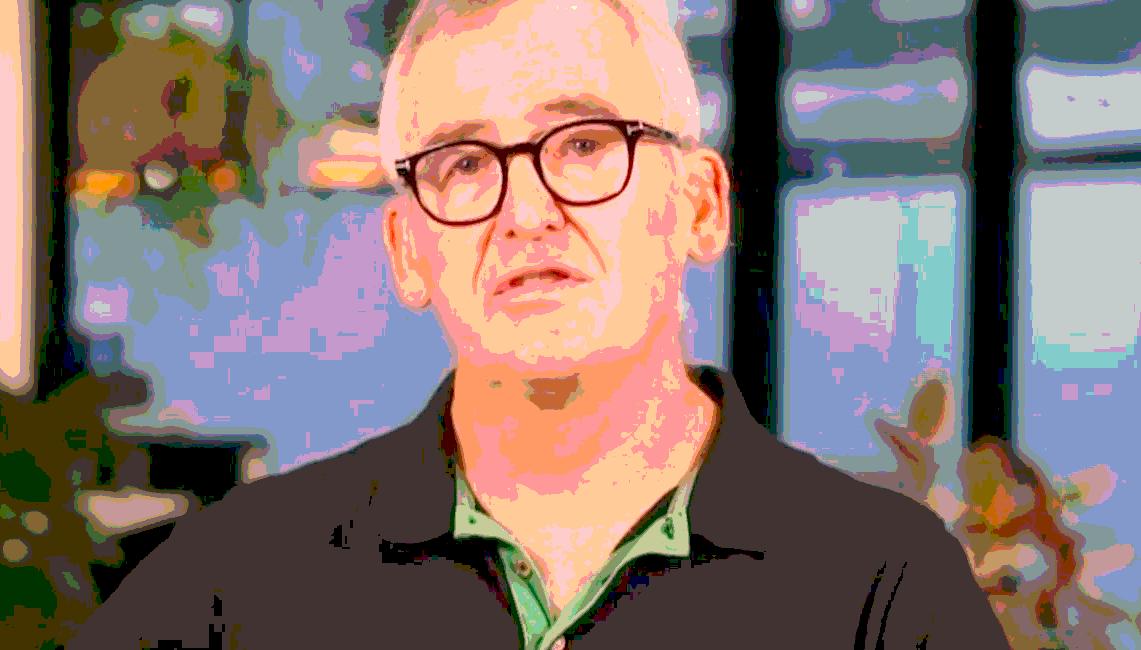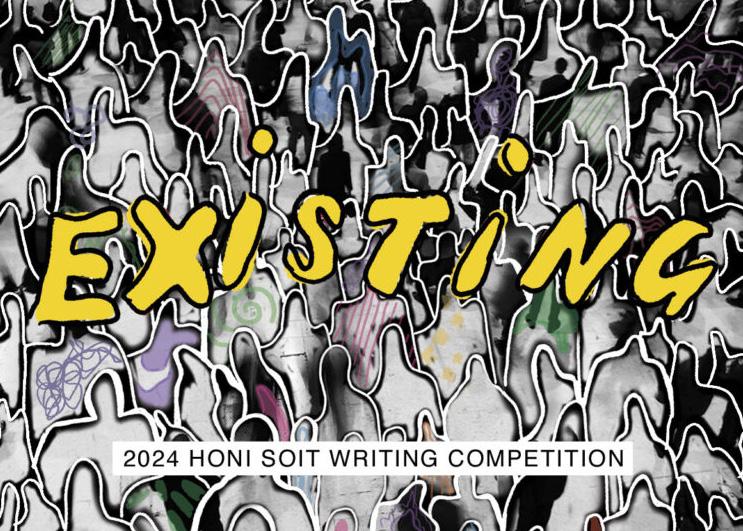
week two, semester one, 2024


week two, semester one, 2024
Honi Soit is produced, published and distributed on the stolen land of the Gadigal people of the Eora Nation. Sovereignty was never ceded. For over 235 years, First Nations peoples in so-called ‘Australia’ have continued to suffer under the destructive effects of invasion, genocide, and colonisation. As editors of this paper, we acknowledge that we are each living, writing, and working on stolen Gadigal, Wangal and Bidjigal land, and are beneficiaries of ongoing colonial dispossession.
We acknowledge that the University of Sydney is an inherently colonial institution which is not only physically built on stolen land, but also ideologically upholds a devaluing of Indigenous systems of knowledge and systematically excludes First Nations peoples. We recognise our complicity in such systems. We strive to remain conscious of, and actively resist and unlearn, colonial ideologies and biases, both our own and those perpetuated by the University and other institutions like it.
As a student newspaper, we pledge to stand in solidarity with both First Nations movements and all Indigenous struggles toward decolonisation worldwide, endeavouring to platform Indigenous voices. Honi is committed to countering the exclusion, censoring, and silencing of Aboriginal and Torres Strait Islander perspectives in mainstream media.
Always was, and always will be Aboriginal land.
Uni fucks up Advanced Studies accreditation...
There’s Legionella at Fisher...
20th week of Palestine protests...
University Accord report...
Finding a job as an international grad...
Surviving admin hellscape...
Remembering the Sydney Push...
Have you (possibly) breathed in the asbestos?
A student voice separates Judaism and Zionism... Labor’s Art Policy...
Being a chronically ill student...
Probing public education...
A chat with the New Yorker Cartoonist...
A spotlight on Vertigo...
Cheese Extinction!
Back to the playground...
Writing on the wall...
Musings on museums...
Anatomy of Wentworth
RIP USyd Revue
Entering the House of Gods
Arts, books, plays
OB reports
Cruciverbalists and comedians go here
...4 ...4 ...5 ...5 ...6 ...6 ...7 ...7 ...8 ...8 ...9 ...10 ...12 ...12 ...13 ...13 ...14 ...15 ...16 ...16 ...17 ...19 ...20 ...22–23
Editors
Valerie Chidiac, Aidan Elwig Pollock, Victoria Gillespie, Ariana Haghighi, Sandra Kallarakkal, Zeina Khochaiche, Simone Maddison, Angus McGregor, Amelia Raines
Contributors
Simar Batra, Lachlan Griffiths, Veronica Lenard, Imogen Sabey, Grace Street, Lotte Webber, Gabrielle Woodger, Kate Zhang
Artists/Photographers
Huw Bradshaw, Bipasha Chakraborty, Grace Street, Regina Wu, Maggie Yang
Living in a Western liberal democracy, we often take public institutions for granted. In reality, public education, healthcare, a robust media landscape and everything in between exist in a constant fight for survival. They depend on political but also social maintenance.
Often that lack of maintenance manifests itself in physical ways. The discovery of Legionella bacteria at Fisher Library and asbestos sites popping up all over the city area are tangible reminders that the role of government has to be an active one. Regulation, oversight and administration are imperfect and deafening but remain essential.
In this edition, you will find critics of those institutions. How we treat teachers, international students and those with chronic health conditions is an indictment that we as a nation have become politically stagnant. Medicare was repealed just six years after it was introduced for the first time in 1975 and winning the right of free education for all took decades of protesting and radical union action. We will lose what we have if we turn our eyes away.
Examining the roots of our own campus activism in Sydney and promoting current pushes to free Palestine and combat the cost-of-living crisis remain the most important tasks Honi has.
You will also find discussions on how cultural institutions shape those movements. The nationalism contained in museums and the messaging built into the popular novels we read often define how the average citizen engages with politics.
The announcement of the final report of the University Accord is an opportunity for a government that has played it safe since its election in 2022 to show voters they are willing to provide the socio-political maintenance we need.
To be a leftist is inherently the belief that people should have autonomy and ownership of politics. May this issue inspire you to take on that ownership emboldened by the collective need for action.

Wednesday, 28/2
The Veils w/ Sarah Belkner + YEEVS @ The Lansdowne
Cheap Trick + The Angels @ Enmore Theatre
Thursday, 29/2
The Chemical Brothers w/ The Presets, Anna Lunoe + James Holroyd @ Sydney Showground
HighSchool w/ Radio Free Alice + Lucy Lamb @ The Lansdowne
High School Sweethearts w/ Allerdyce, Lindsey + Denison @ The Vanguard
Friday, 1/3
Avalanche w/ The Polymics, Packing Dhaka + The Hush @ The House of Music & Booze
Blind Pretty + Hey Lenny @ The Trocadero Room
Stitcher w/ Lemonise @ The Botany View Hotel
Bloody Legend Residency w/ Big Red Fire Truck @ Ramblin Rascal Tavern
Saturday, 2/3
DZ Deathrays w/ These New South Whales, The Buoys, Arse + more @ Crowbar
Dirty Disco + Rooftop Parade Viewing Party @ The Burdekin
Mardi Gras Night - Parade Afterparty @ Universal
Pride In The Yard @ The Alex Candyland XXL @ Ivy
Sunday, 3/3
Newtown Record Fair presented by 2SER @ The Bank
Guide: Rosina Carbone
Hello editors.
I’m assuming you’re being paid to promote “the good party”, because it is a shit political party and isn’t honi’s vibe.
So how much are you getting paid to be shills for a random political party? Or is this piss take?
— Your Favourite General Secretary, Jacklyn Scanlan (Econ III)
Hi Jacklyn,
Yes. The docile little Honi editors are told how much space to sacrifice for advertisements each week... The eds are looking into the history of advertisments in Honi, and are hoping to do a deep dive into why it continues to happen to us.
*sobbing* And now a word from our sponsors!
— Honi Editors
If you have a thought, query or complaint, promptly direct them to our inbox: editors@honisoit.com
Imp noun: a small, mischievous devil or sprite.

Cartoon: Huw Bradshaw
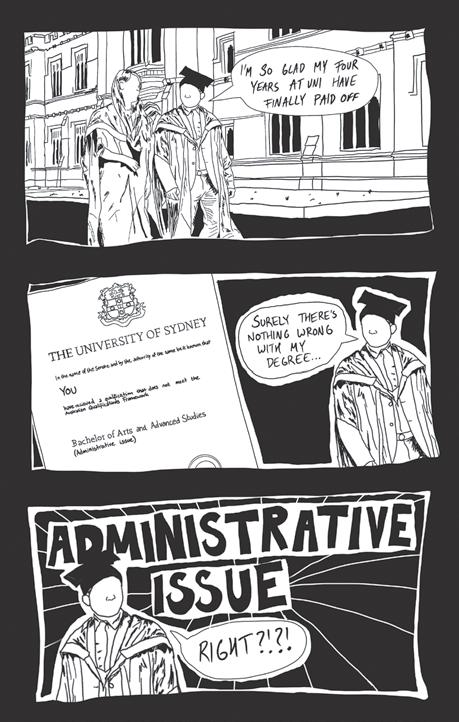
L-Word
Hello editors,
Why don’t you have a love advice column I need advice? Are you not paid to run a newspaper?
Hello unlucky-in-love, True! We need more content.
For those wanting sage wisdom from the lucky-in-love, email us at editors@honisoit.com

Last Week
This Week
Submit your best caption for the above to editors@honisoit.com for a chance to WIN and be published in the next edition!
Winners receive a personalised limerick from Angus McGregor.
Winning caption:
“Put the Advanced Studies degree in the bag, slowly” — James Wily, (Arts V)
Winner’s reward, as promised:
We thank you for your answer, James When Advanced Studies went up in flames.
Your caption’s resonance
Revealed the Chancellor’s negligence!
Angus didn’t write this. By Amelia Raines
Simone Maddison reports.
The University of Sydney has issued a follow-up email to current Bachelor of Advanced Studies students across all faculties this morning regarding a resolution to the administrative issues with these degree certificates flagged to staff, students, and the Australian Tertiary Education Quality Standards Agency (TEQSA) last Friday.

In her update, Deputy ViceChancellor (Education) Joanne Wright stated that “the University has agreed on an approach” to address these issues. This means the University will “now be making some administrative changes to the Bachelor of Advanced Studies to ensure graduates are awarded degree certificates that clearly show they’ve fulfilled the requirements of two degrees.”
Two new certificate pathways were outlined in the email for those who complete a four-year Bachelor of Advanced Studies combined degree in any faculty. At this stage, they will receive “either two Level 7 Bachelor degrees or a Level 7 Bachelor degree and a Level 8 (Honours) degree, for those who have fulfilled the requirements of honours.”


These solutions are intended to directly address the two key issues identified last week, being the misrepresentation of Bachelor of Advanced Studies qualifications, as well as the conflation of Level 7 undergraduate and Level 8 honours achievements, on degree certificates.
Wright assured students, “we’ll be working through this administrative process as quickly as possible and will keep affected students updated.” She also noted that “Bachelor of Advanced Studies students do not need to do anything at this time” because their unit of study selections “remain unaffected”, and that students enrolled in other degrees “are not affected in any way.”
This information comes two days after the University’s Academic Board called an out-of-session meeting to discuss the key risks impacting different cohorts and to settle on a satisfactory resolution.
Honi Soit has been made aware that Wright opened Monday’s meeting with an apology, stating “I’m sorry this has happened” so close to Welcome Week and the first week of the academic year.
Angus McGregor and Ariana Haghighi report.
Low levels of Legionella bacteria have been detected in a Fisher Library cooling tower on the Camperdown/ Darlington campus of the University of Sydney. NSW Health is calling for symptom monitoring after three people who contacted Legionnaires’ disease had recently spent time around the USyd campus since late January.

In an exclusive statement for Honi Soit, a USyd spokesperson said:
Honi asked the University if there would be any changes to how cooling towers were cleaned or inspected. In the original email, the spokesperson maintained that the University “regularly tests our buildings and cooling systems in line with NSW Health’s guidelines and standards.”




‘‘Low level contamination was identified in the external part of a tower at Fisher Library. We’re working with Sydney Local Health District and have acted swiftly to disinfect and clean the tower and those in the surrounding area as advised by SLHD.”
The University is currently cleaning the infected tower and all other cooling towers on campus. The disinfecting of all towers is expected to be complete by the end of this weekend.
The University has told any students who exhibit the symptoms of Legionnaires’ disease, such as fever, chills, coughing, shortness of breath, or a severe chest infection to seek medical advice immediately, especially members of the University community who are immunocompromised.
The email assures students that health authorities have confirmed that all campus buildings are safe to occupy and classes will not be impacted.
Legionnaires disease cannot be spread person-to-person, but from exposure to contaminated water particles. Symptoms can develop up to ten days after exposure.
This detection follows a Legionnaires disease alert in Sydney CBD on January 3, prompted by seven people developing the disease after spending time in that area.
NSW Health issued a statement shortly after the announcement echoing the University’s call for vigilance of symptoms for those who had been around the Camperdown/ Darlington campus or Victoria Park in the past 10 days. NSW Health reported that three people who had developed the disease had “spent time in the area since late January”.
NSW Health confirmed that “the positive cooling tower has been decontaminated,” while reminding all building owners that they “must ensure that their cooling towers are operated and maintained in compliance with the NSW Public Health Regulation 2022.”
Wright also hinted at the possibility of creating a “new exit award” for undergraduate students attempting to drop their Bachelor of Advanced Studies at the end of their three core years of study.
The Academic Board has nonetheless resolved to reissue all past and current degree certificates, and has proposed an internal investigation “to understand how this happened” and to “make sure it does not happen again.”
However, there is one small cohort of five-year degrees that Academic Board staff “have not quite worked through yet.” Current and enrolled students in a Bachelor of Music/ Bachelor of Secondary Education with a Bachelor of Advanced Studies must be treated on a “case-management basis” to best navigate the intricacies of combining these three degrees. The Academic Board’s main concern here is ensuring that all of these students can complete an appended Honours degree.
Honi was also informed that during questions from staff and student-appointed representatives at
Monday’s meeting, Wright revealed these solutions have been neither conceptualised nor proposed in consultation with students. While this may change given the Academic Board’s recent approval of two remediation options, those affected remain absent from the design of this policy change.
In response to the Academic Board’s handling of the issue, and the nature of the issue itself, SRC President Harrison Brennan told Honi that “whilst this may not have any significant impact on the studies of current students or graduates, it is nonetheless a massive blunder from university management. The issue dates back to 2016 with the creation of the Bachelor of Advanced Studies degree, a rushed proposal that has clearly backfired for the university and is having repercussions for its students.”
More information about the proposed changes is available on the University of Sydney’s website. Honi will continue to cover additional information as it arrives.
Angus McGregor and Ariana Haghighi report.
Education Minister Jason Clare has released the final report of the Australian University Accord. Led by Dr Mary O’Kane, former ViceChancellor of the University of Adelaide, the panel included former Nationals Minister Fiona Nash as well as former Labor Minister Jenny Macklin alongside other experts.
The report is the largest review of the sector since 2008, taking into account 820 public submissions, as well as 180 meetings with stakeholders.
The Accord originated as a preelection promise in 2021 by thenShadow Minister for Education Tanya Plibersek who wanted “to end some of the political bickering over higher education policy by establishing an Australian University Accord.”
An interim report was released in July 2023, containing 70 policy ideas which ranged from a levy on international students to expanded measures to attract and maintain regional and Indigenous students at university.
This report outlines numerous policy objectives accompanied by quantifiable targets for 2050. The goals are split into the following categories: increasing skills through equity, improving the student experience,
building on quality research and systematic changes.
Some targets for 2050 set by the government include:
• Lifting the tertiary attainment rate of the working-age population from 60% to 80%
• Increasing the proportion of university-educated Australians aged 25-34 from 45% to 55%
• Students from underrepresented minority backgrounds (First Nations students, students from lower socio-economic backgrounds, disabled students and students from a regional or rural area) must have a university participation rate proportionate to the Australian population
• Establishment of a National Regional University and expansion of the regional Study Hubs program
• Standardising career advice frameworks given to students all over the nation
• Replacing the Jobs Ready Graduate package with a studentcontribution system based on
Grace Street reports and photographs.
On Friday, a rally hosted by the City of Sydney for Palestine, Extinction Rebellion, and other climate activists set up outside Minister for the Environment and Water, Tanya Plibersek’s office in Redfern to protest the environmentally and socially disastrous genocide of the Palestinian people. Each speaker condemned Israel’s humanitarian and environmental crimes, specifying the interconnected impact of climate change and the imperialist war machine. The event began with a team effort of laying down the massive Palestine flag along the road.
Co-chair Jana Fayyad from Palestine Action Group and Palestine Justice Movement opened the rally with chants of “Israel is a fascist state,” and expounded beyond the phrase “Palestine will be free” to say “Palestine will free us, and will free oppressed people all over the world.” Co-chair, Ash, also announced that while the police were there to ensure safety, but were like the “pro-genocide” politicians who need “reminding of what peace and non-violence really look like.”
Introducing the City of Sydney for Palestine group, Ash spoke to the successful passing of a motion in the local council for an immediate,
potential lifetime earnings, and modifying Higher Education Loan Program (HELP) loans to reduce financial burdens of repayment
• Adjusting criteria to student welfare payments to increase access
• Reducing placement poverty by providing financial support
• Establishment of a National Student Charter and National Student Ombudsman for Student Safety Research
• Establishment of a new research fund for universities
• Planning for government operations and policy to rely more on tertiary-level research
• Increasing the number of doctoral candidates employed in their field of research
• Establishment of an Australian Tertiary Education Commission to provide leadership for systematic changes
• Establishment of an internal First Nations council to advise ministers
• Developing a new funding model which prices the cost of teaching based on its discipline
Some of the most controversial aspects of the Interim Report like the international student levy which Universities Australia (UA) and the Group of Eight (Go8) called a tax on success have been dropped in the final report. The levy was also expected to reduce the amount of international
permanent ceasefire. Notably, this came just a few days before Anthony Albanese’s “piss-weak”, “pathetic” and lacklustre call for a conditional ceasefire that Plibersek herself had signed onto.
Ethan Floyd, SRC First Nations’ Officer and Wiradjuri and Wailwan activist, invited us to say dyiramadilinya badhu gadigaldya ngurambang [I am proud to be on Gadigal land]. Exploring the key aims of the rally, he expressed that Country is essential for Indigenous peoples, with Country being land, water, sky, and an ancestral being.
Floyd shared stories of frontier and colonial violence passed down through their family, noting that these experiences of violence, apartheid and dispossession are shared by Palestinians. Committing to the fight for Indigenous people around the world, Floyd concluded that “this is what solidarity looks like – to know our feet are on Gadigal land, but that our hearts are in Palestine.”
Sarah Snaweesh, a key organiser from the Families for Palestine picket outside of Albanese’s office in Marrickville, spoke to the crowd. A symbol of Palestinian culture and pride, Snaweesh wore a Palestinian thobe of
students studying in Australia.
cream linen and colourful embroidery that is particular to Al-Khalil (now known as Hebron).
Articulating a communal frustration, Snaweesh shared her previous belief in the power of peaceful protest that had been shattered by weeks of unsuccessful sit-ins and attempts to speak to leaders about their support for Israel. She demanded that Plibersek “remember who she was when started her journey in politics” and her statement that “Israel is a rogue state which consistently ignores UN resolutions, whose ruler is a war criminal responsible for the massacre of civilians.”

Showing that the fight for the justice of oppressed people and for climate justice go hand-in-hand, Plibersek (or her office, at least) witnessed a harsh condemnation of her failures to represent her constituents, to fulfil her role as Minister for the Environment and Water, and to break away from the Labor party’s line of support for Israel.



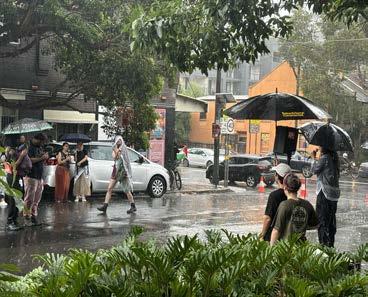




Snaweesh listed off horrifying statistics of the Israeli Occupation Forces’ destruction to Palestinian lives and land; the damage of the first 60 days of the war on Gaza was equivalent to burning 150 tonnes of coal, rebuilding the 100,000 damaged buildings of Gaza would require 30 million metric tonnes of global warming gases (more than the annual emissions of 135 countries), and that a continuation of the Israeli offensive in Gaza is estimated to lead to another 80,000 Palestinian deaths from injuries and disease.






Clare emphasised in a statement that implementing any of these recommendations would take years: “This is a plan not for one budget, but a blueprint for the next decade and beyond.”

He highlighted that in the future “we will need 80% of the workforce to not just finish high school, we will need them to finish TAFE or university as well.”
This new report does not suggest a direct implementation of its recommendations, but rather it initially calls for a committee to oversee all reforms and explicitly wants a “staged approach.”
Clare has had the report since December and the government is “considering the recommendations.”
The National Tertiary Education Union (NTEU) said in a statement that it welcomed the report, finding that “consistently high rates of casualisation” have negatively impacted the sector.
National NTEU President Dr Alison Barnes called the report “ambitious” and said it “has the potential to create better universities but only if it is implemented correctly and funded properly.”
She also argued that “rolling back the unfair and poorly designed Job Ready Graduates scheme” was an essential part of future reform.
The NTEU also highlighted First Nations equity and funding the Higher Education Future Fund as a core part of the report that needed to be implemented.
The hot weather turned to a gusty downpour, exemplifying the harsh, modified weather patterns brought on by climate change issues addressed in the speeches. The police retreated to their cars as rally attendees braved the rain with the help of trees, umbrellas held over microphones, and keffiyehs as head coverings. The Palestinian flag was quickly moved to safety as the rally carried on.
River Verwoord from Creatives4Palestine chilled us further with her eerie poem “Dear Tanya,” in which she launched into a damning question-time of Plibersek: “Is your conscience clear, Tanya? Should I speak to you on something we actually pay you for, something you claim to care about, Tanya? You’re the Environment and Water Minister. Let’s talk about that then, Tanya. The equivalent of two atomic bombs, Tanya. Two.”
Fahimah Badrulhisham from the Muslim Collective linked the aims of the rally to the hot and temperamental day, pointing out the unanswered calls of First Nations and young people all around the world amidst this climate emergency. She called out Israel’s exploration of gas off of the Mediterranean coast to unjustly enrich itself using stolen land, while Palestinians are restricted to waters only within 20 nautical miles of the coast.
Lilli Barton of Wage Peace commended the beautiful intersection of groups at the protest, and explained Wage Peace’s motto of “earth care, not warfare”. They delved into the corrupt cleanup industry which cleans up wartorn areas, like Afghanistan, under the guise of benevolence but with the primary motivation of profit and control.
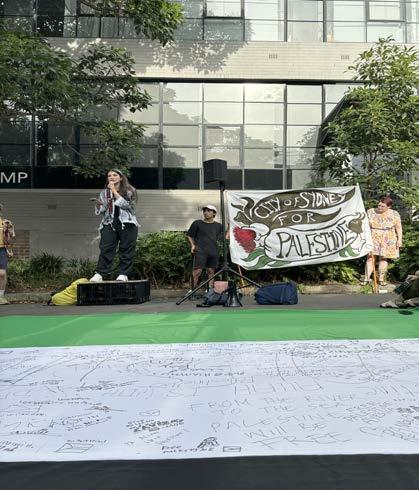
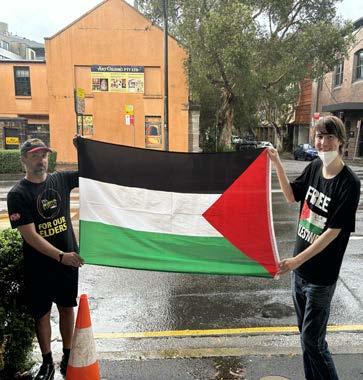
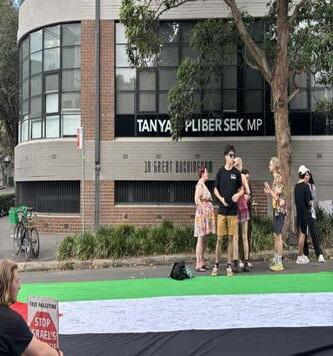
International graduates are struggling to find a full-time job related to their ideal future career path in Australia.
An international graduate, who would like to remain anonymous, paid an agency $3,000 for an interview for an unpaid internship. She got the internship ten months after graduation. Months later, as her internship ended, she started to look for a job again.

of Digital Communication and Culture. Hoping to find a casual job to support himself and an internship relevant to his degree, he has sent job applications as much as he can through online platforms in Australia such as Seek and LinkedIn.
issues or change of future plans. It is also hard for international students to gain more work experience and become more competitive in the job market before graduation, as the student visa has a restricted working hour cap of 48 hours per fortnight.

2024-2025 Permanent Migration Program, Go8 states that international graduates are “a significant untapped resource”.


“Finding a job is easy; but finding an ideal job is difficult,” she said. “If you want to get a job and stay in Australia, you should try harder and perform better than the locals.”
She had worked for about two years in a part-time retail job, as well as five years in several other casual jobs in hospitality. Despite many years of customer service and working experiences in Australia, the journey to seek a full-time job relevant to her degree is still not easy for her.
A Grattan Institute report published in October 2023 titled “Graduates in limbo: International student visa pathways after graduation” found that international graduates find it hard to find a skilled, full-time job that matches their ideal career. They also tend to earn less than the average domestic graduate.
Before their graduation, it is also hard for international students to get ideal internships and casual placements. University of Sydney student Vaishakh Subin is in his final semester of Masters
Subin said he was also “in limbo” as an international student. He said it was frustrating that companies only reply after months or don’t reply at all, leaving him hesitant to plan his next step. He said the companies should be more “proactive” in responding.
As the companies don’t respond to Subin, he can only imagine the reason why he was not given a chance. He said the companies may prefer candidates who are more experienced, more qualified, and more culturally aligned with the group.
Another international graduate believes the problem is that many students often have higher expectations about their future jobs. “You can’t expect the companies to hire you just because you’re a graduate from a top university. University graduates are everywhere,” she said.
Some international students worry that the company may consider it to be extra risky and costly to hire them. Students worry that they may be rejected just because they have no permanent residency — companies may assume that they would go back to their home country because of visa
The Grattan report suggests poorer English, weaker local networks, and discrimination as other reasons.
Many international students and graduates consider online applications as their main approach to seek a job, rather than networking. Subin said he once found a volunteering job through his friend, but he doesn’t consider networking as playing “a major role” in his future job seeking.
Sydney University Postgraduate Representative Association (SUPRA) President Weihong Liang said universities should stand together with international students and graduates for their fair working rights in Australia, as well as providing more units that offer internship opportunities rather than a list of information for students to get hands-on experiences and prepare them for their future careers.
The Group of Eight (Go8), a union of eight universities in Australia, highlights the data from a report by the Treasury that only around 16 percent of international students got permanent residency between 2000-01 and 201314.
In their submission to Australia’s
“These graduates are already onshore in Australia; have invested significant time and experience within their community and have skills and capabilities that have been verified to Australian standards, ” they wrote.
The Submission also stated that when the graduates become more experienced, they help “ensure a workforce pipeline of talent” and address “workforce shortages in critical industries”.
Australia has reduced the eligible age for temporary graduate visas from 50 to 35 years old and raised the Temporary Skilled Migration Income Threshold to $70,000 a year. Facing more restrictions while chances for growth remain limited, where would the future be for international graduates?
Liang mentioned that universities should also help international students who would like to pursue their future career in their home country. Universities should maintain a good global reputation, monitor graduates’ competitiveness in various industries, build connections with local alumni and local companies, as well as hold more industrial events.


Veronica Lenard wants to help you through the shitshow.
I still remember the moment when I read the email. The panic that rushed through me as I thought that my plan was not going to work out. I was almost through my first year, having worked towards transferring into the degree I’d been wanting to study, only to feel like my hopes had been crushed. I had received advice that what I wanted to do wasn’t possible, despite being told otherwise at the Open Day a year earlier. It was. But I didn’t know that yet.



that you can’t. All it takes is a line of the sub point that lets you do more than you were told that was possible. You will (more often than not) know more about your degree than the person who is helping you.
The problem is almost never the fault of (or often entirely fixable by) the person you are talking to, so always be kind to the people helping you. The root of your problem is a corporatised university that continues to fragment their administrative processes, whilst understaffing the areas that manage these processes. But whilst we work on changing the broader system, here’s my survival guide for the one we are living in at the moment.
Familiarise yourself with the rules of your degree as early as you can. Understanding the handbook for your degree will help you figure out what you can do, even when the system says
Expect a two week turn around per request, minimum. If you can apply earlier than that, do it as early as you can. I once had to wait eight weeks to be properly enrolled in my subjects because it took three different requests, each taking their own fortnight, with an additional two weeks for remaking a request after it wasn’t completed.
Transferring degrees brings you both into the degree that you want, but also into a new pile of administration to deal with. Credit applications and personalised progression plans can make things more confusing, but if you keep track of your own information early (or seek academic advice), you’ll know how many subjects you need to complete for each part of your degree and where you are up to throughout.
If you are changing your major or transferring into a degree that does not accommodate for students to start in any semester except semester
one of first year, it can be quite useful to be able to complete a second year unit at the same time as its first year prerequisite, since most subjects run once a year.
I found that the magic words in these applications were “degree progression.” A polite explanation that you are trying to ensure that you meet your degree progression and that you are confident in your ability to complete the unit can get you further than you think. It’s important to make sure that you can catch up on the assumed knowledge, but if you are willing to work hard and ask for help when needed, it’s a doable path to get you a little further in your degree faster.
Sometimes you will do everything right and your request will be rejected. Despite having already received approval (and completed) three of four additional units I was trying to do, my application for the final one was refused. It took some more emailing, with context and persistence, but I eventually made it into the class.
If something feels wrong, it probably is, so just send the email. It’s
easy to feel like it’ll just work itself out in time but sometimes it is actually wrong in the system and you are the person most likely to notice.
Keep track of useful links when you stumble upon them. You can use the universal timetable to see all the times and locations of any class that you are looking for. If you study Law, the timetable on the Law Student portal includes this information along with the teacher.
Design the degree that you want. Talk to people when you can. Push the boundaries to the edges of your handbook (and even further if you can). May you have less administrative dramas than I had.


We must doubt everything: The complexities of the ‘Sydney Push’
Lachlan Griffiths looks back.
“Manning Clark wrote that the 1950s in Australia were “years of Unleavened Bread.” Robert Menzies was in the Lodge, and the Queen was in the Palace. Australia was quiet and well-manicured. The “Sydney Push” emerged from this climate of conformity, pushing against the tide of normality. In the history and theory of the Push, one finds a distinct moment of anti-establishment experience juxtaposed against conventionality. The Push helped initiate a longer Australian tradition of activism and intellectual political debate.
The Push was disparate, but can be basically surmised as a loose confederation of students, writers, musicians, and hangers-on who concerned themselves with a life of what A.J. Baker termed “permanent protest.” It was a breakaway from the “freethought” of philosopher John Anderson. These activists were inspired by Descartes’ claim that “we must doubt everything,” and a devotion to Wilhelm Reich and the French Situationists. Socrates had famously spoken against the unexamined life. Here was a group of people very keen to examine life. They were anarchic and resented institutions. As member George Molnar put it, the Push, at its heart, advocated an “anarchic protest against those in power.”
It is in this spirit that the basic tenets of the Push emerged: a desire to protest everything, everywhere. The historical implications of this Bohemian bonhomie is obvious.
The Push, in their commitment to questioning authority, and especially their opposition to South African apartheid, marked themselves out as an early example of explicitly anti-racist and anti-colonial debate in Australia.
In another way, they helped lay a foundation for much of the activism in the 1960s and 1970s. In a later incarnation, Push associates were involved in the green-ban campaign that preserved much of Sydney’s historic architecture. Similarly, their philosophical objection to established authority informed the anti-Vietnam War movement of the ‘60s. It also spurred the development of the satirical magazine Oz, which would become a countercultural touchstone of the ‘60s and ‘70s, and the subject of an infamous libel trial, illustrating how the Push was something of an intellectual influence on the social change of the 1970s.
However, as Andrew Moore’s obituary of Push leader Darcy Waters suggests, the Push believed that “fundamental change was impossible.” This presented an issue: the group’s concern with permanent protest seemed at odds with their resignation to the impossibility of change. So, they accepted fate with gin-sodden pessimism. The Push’s praxis was drinking, promiscuous sex, and intellectual debate. Such evenings spent in a haze of smoke at the Royal George Hotel, were dubbed by AJ Baker as “critical drinking.” Members would argue into the early hours of the

morning about philosophy and politics.
The most glaringly obvious issue with the Push was the clear gulf between their claimed ideals and the reality of their circumstances. As much as the Push claimed to be in favour of anarchism, free love, Cartesian skepticism and political activism, they were far more content to drink and argue than actually do anything. Despite the “anarchic protest” that Molnar and others claimed underlay the Push was really, as Frank Moorehouse wrote “a club for talking, drinking, and fornicating.” Therefore, the Push was not a political group as much as it was a social circle who liked philosophy.
The longstanding juxtaposition between Push theory and Push practice, along with the disparity of the group, made dissolution inevitable. Elizabeth Farelly highlighted how the Push was a predominantly male group. Despite their protestations of “permanent protest,” and “free love,” the Push was still wedded to the patriarchal and sexist gender conventions of the 1950s. Farrelly observes how many male push members treated women as “sexual conveniences.” The writer James Franklin was more blunt, admitting that, “Push men were beasts.” Their attachment to freedom and liberty was only true when it suited the blatant misogyny of its male participants. Philosopher David Armstrong argued that the Push’s apparent defence of polyamory didn’t derive from a principled philosophy, but rather from a desire to “justify their
Ariana Haghighi and Sandra Kallarakkal (possibly) have .
Following reports of asbestos in the Victoria Park mulch, the University of Sydney sent an email to all students and staff disclosing that there are some sites on the Camperdown campus with possible asbestos. The majority of the contaminated mulch supply was located in its packaging and has been isolated for removal. The University has identified and fenced off the areas where the mulch is being tested. The presence of undisturbed mulch does not pose significant risk.
We toured campus to spy the three (possible) asbestos-ridden spots: Science Road, John Woolley Building and Manning Road.
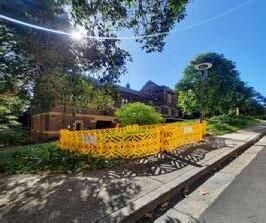
exploitation of women.”
In the view of Anne Coombs, the Push fizzled out for two reasons. Firstly, young people by the late ‘60s and early ‘70s “believed in many of the things that the Push had been advocating.” Similarly, the 1972 election of Gough Whitlam meant that the conventional Push opposition to established politics dwindled as a more progressive administration entered government. The pubs they frequented closed and old Sydney was built over. The decade and a half of Bohemian anarchism, beer-soaked sexuality, and philosophical debate came to a close as society changed. No longer was protest or debate the exclusive, coffee-house right of an intellectual vanguard.
So what, if anything, can one take from the Push?
There is value in Bohemia. In the Push’s anti-racism, and their commitment to intellectualism and debate, it marked itself out as a group of unique non-conformists that are central to a larger tradition of Australian radicalism. Their staunch opposition to authoritarianism and racism in all their vile forms meant that the early Push protests gave voice to a tradition of modern social activism and consciousness that remains today. In a way, the Push’s greatest continued relevance is as an historical force, a barometer of the ways Australian thought changed through the 1960s.
1. What is your major?
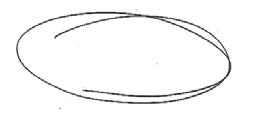
A. English
B. Media and Communications
C. Engineering
D. Veterinary Science
2. How many days do you come onto campus?
A. 4 days a week
B. Twice a week
C. Mostly in weeks 12 and 13
D. Lockdown has been lifted?

3. What is your relationship with the term ‘BNOC’?
A. Have to admit I am one
B. There are a couple in my classes
C. Oh, I steer clear of them
D. Never heard of it… in fact, what is this ‘newspaper’?
4. What’s your ideal campus lunch?
A. Lining up for the free lunch at Manning Cantina
B. Oakberry Acai at Manning
C. Vegan chicken at LoveBuds
D. Guzman y Gomez at Broadway
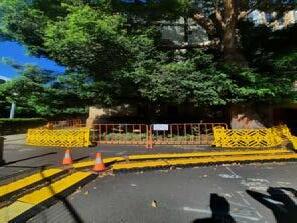
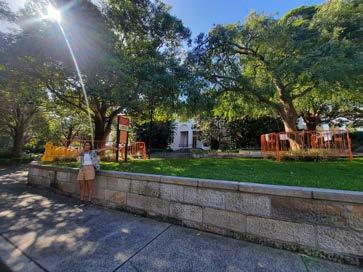
5. Where do you spend your hourbreak between classes?
A. Lawns outside the Education Building
B. Brennan Maccallum Learning Hub
C. Courtyard Café
D. Abercrombie Business School
If you answered…
Mostly As…
You have (possibly) breathed in the (possible) asbestos.
Mostly Bs…
You may have (possibly) breathed in the (possible) asbestos.
Mostly Cs…
It is unlikely that you have (possibly) breathed in the (possible) asbestos.
Mostly Ds…
Do you even go here?

Anonymous reflects.
Australian Jews critical of Israel walk a lonely road. The Australian Jewish community is one of the most hegemonically Zionist and pro-Israel of any diasporic community. Its central organs, the Executive Council of Australian Jewry (ECAJ) — led by Alex Ryvchin, and its sister organisation, the Zionist Federation of Australia (ZFA) led by its Melbourne President Jeremy Leibler, have consistently opposed calls for a ceasefire in Israel’s ongoing war on Gaza, condemned the International Court of Justice’s issuance of provisional measures against Israel as ‘incentivising terrorism’, and denounced critics of Israel such as UN Special Rapporteur Francesca Albanese.
The Australian Jewish News — the largest publication in the community — is similarly staunchly pro-Israel, celebrating the release of two hostages in Rafah on February 15, omitting any mention of the rivers of innocent Palestinian blood shed for their release. Children are raised in an explicitly proIsrael ideological environment. Moriah College, Sydney’s largest Jewish day school, sends its students on a six-week program to Israel in Year 10. Many, if not most, young Australian Jews spend their summers at Zionist youth camps, Habonim Dror, Netzer, Hillel, B’nei Akiva, which foster youth engagement with Israel, before sending them on very heavily subsidised trip to Israel for a year post-High School, known as Shnat (Hebrew for ‘Year’) — the equivalent of Birthright in the United States.
It is no wonder then that young Jewish Australians are overwhelmingly pro-Israel. The Australian Union of Jewish Students (AUJS) lists ‘Zionism’ as one of its four constitutive pillars. Its website states that it seeks to “to promote a positive image of Israel on campus” — demonstrating the links between student organisations and ‘Hasbara’, organised Israeli public diplomacy — or as its detractors see it, propaganda justifying the occupation of the Palestinian Territories and the mass death created by the war on Gaza. Young Australian Jews are conditioned to believe — and perpetuate the myth, that Israel is a fundamental part of their Jewish identity. That any criticism of Israel is a criticism of them. When pro-Israel Jews claim criticism of Israel is antisemitic is often not only a cynical attempt to shut down debate, but also a genuine expression of their own fears of antisemitism. It’s for precisely this reason that it is such a common theme among anti-Zionist or non-Zionist Jews that they ‘unlearned’ this conditioning, a process of slow exposure of what the modern Israeli states truly represents. There are few Jews who are critical of Israel at 20, but many at 30. Internal contestation of deeply held beliefs is a careful and difficult psychological process.
It is important to note that mainstream Jewish institutions permit some criticism of Israel, for example, Netanyahu’s controversial gutting of the Israeli Supreme Court’s power to review
legislation.Crucially,such criticisms only challenge aspects of Israel’s rightward shift that threaten to tear down Israel’s carefully constructed self-portrait as a liberal, egalitarian, democratic state. These are ultimately self-serving, protecting Israel’s reputation — and as such the continued legitimacy of the occupation — as they are altruistic. Jewish organisations will cite these as examples of frank criticism of Israel, when in truth they simply reflect what is permissible within a narrow and carefully considered overton window.
For those Australian Jews willing to cross the Rubicon and criticise Israel’s many violations of international law, a grim wasteland awaits. In ways subtle and explicit, you may slowly be excluded from the mainstream of the community. Disparaging eyes follow you at Synagogue. You may be tarred with slurs such as ‘Kapo’ or labels such as ‘self-hating Jew’. You will receive messages and calls criticising you, or your parents will receive those messages and calls, rebuking them for their daughter or son signing a petition calling for a ceasefire, or appearing on B-Roll footage of a Palestinian protest in the city. You will find it harder to engage with your community, not only out of despair for the atrocities they refuse to condemn, but out of a fear that they no longer even want you.
In online Jewish community groups, anti-Zionist Jews are condemned and ridiculed, while nonJewish Zionists — such as provocateur
Angus McGregor looks at the arts.
When Albanese’s cabinet announced its culture policy ‘Revive’, last year, it joined a long list of Labor governments that turned to the arts for an easy political victory. Whitlam founded the Australian Council of the Arts, while Keating pushed the ‘creative nation’ in 1994. Albanese’s $286 million capital injection over four years comes at a time where the domestic arts industry is under more pressure than ever.
This policy represents a sizable shift from a past emphasis on funding areas of the arts that experience market failure to a system designed to make proactive investment in commercially viable projects and align the arts with other government initiatives.
Dr Scott East, Professor of Cultural Studies at UNSW and part of a group of academics involved in the design of the policy, pointed out that “broader federal government visions such as the Uluru Statement from the Heart and tackling sexual misconduct have been folded into this cultural policy, which is an interesting approach in itself.”
Culturally, Australia punches way above its weight. Only the size of many major world cities, Australian actors have taken home 55 Academy Awards,
while Australian musicians are some of the most streamed in the world. However, that soft power is slipping. Emerging economies in Asia taking up more global cultural capital, combined with a decline in government arts funding domestically, mean Australia has slipped from a top 10 ranking in the Global Soft Power Index to number 13 last year.
Soft Power is not just a point of pride for Australia; it is one of the nation’s greatest economic assets. The arts and entertainment industry is worth $17 billion and employs over 400,000 people. Behind commodities like iron ore and natural gas, education, which depends on soft power, is Australia’s fourth largest export.
Strangely, that importance does not extend to our historic treatment of creative professionals. They are expected to work for low salaries and in insecure conditions because their jobs are seen as passions rather than genuine employment. There is also an increasing exception in the general public that music, movies and books should be free. Streaming services like Spotify and YouTube have an artists’ race to the bottom for small cuts
of ad revenue. That is all before the threat of digital technology further puts pressure on artists to stand out and retain ownership of their own creativity.
This disconnection between what the arts provide for Australia and how we repay them was displayed during the pandemic, where almost overnight the industry shut down. The Coalition’s response was catastrophic.
Only 47% of businesses in the entertainment industry remained partially open during the lockdown, compared with 96% of financial services. Rather than providing income

“Soft Power is not just a point of pride for Australia; it is one of the nation’s greatest economic assets. ”
and failed Liberal candidate, Freya Leach are cheered on for stunts such as removing pro-Palestinian flyers on the USyd campus. It is a source of deep personal sadness that for many Jews, simply cheerleading for Israel — an act often beset with ulterior motives in Evangelical eschatology, or by islamophobia, render someone more accepted in my community than the 1,000 years of Jewish blood that flow through my veins, my knowledge of the Torah, my Bris, my Bar Mitzvah, my immense pride at being part of an ancient, learned, and resilient people.
Anti- and non-Zionist Jewish community groups exist. These groups are small, albeit growing in number. While they offer a refuge of sanity among the wider darkness, by their very nature they are formed to provide a bulwark against mainstream Zionism. They are political organisations, no substitute for the wider institutions of the Jewish community. Unlike the US and the UK, where the larger demographics of Jewish organisations allow for a critical mass of anti-Israel Jews to develop, Australia is structurally limited by the size of our community.
The road to Jerusalem stretches out before me. Walking it shall toll my humanity. I stand, transfixed to the pavement wondering how the path that lay at my back had taken me to such a treacherous point.
support, the government denied the arts sector Jobseeker. This was despite the MEAA making multiple submissions to Parliament explaining why those in the arts industry would need special exceptions to receive funds because most are employed in an unconventional manner. Further, non-profit organisations, who make up a large proportion of entertainment, had to show more losses to be eligible for government benefits.
Beyond the pandemic, $200 million of federal funding was cut from the arts during the Coalition’s time in office, not including the infamous cuts to the separately funded ABC and SBS.
At least in principle, Labor seems committed to shifting the narrative towards recognising the material worth the arts provide Australia. When the policy was first announced, Arts Minister Tony Burke said, “our artists are creators and workers. This sector is essential for our culture and for our economy.”
The emphasis on new bodies in the policy has become more of a marketing push than a substantive change. The creation of Music Australia and Writers Australia, two new sub bodies


Living with a chronic health condition presents a myriad of challenges, and for many students, the financial burden can be overwhelming. As university students, we often find ourselves balancing academic responsibilities, part-time work, and social engagements. However, when chronic health conditions enter the equation, this equilibrium is disrupted, and the financial implications can extend far beyond what Medicare subsidies cover.
One of the most significant issues faced by students with chronic health conditions is the cost of managing their health. From medication expenses to doctor’s visits and specialised treatments, the financial strain can quickly accumulate. Unlike full-time employees who may have access to comprehensive health insurance plans through their employers, students are often left to navigate the complexities of healthcare with limited resources on their own.
living crisis. I pay $300 a month for my prescription medication Ajovy, totalling $3,600 a year. Including other migraine expenses (listed below) my expenditure is around $7,000.
I know firsthand the struggle of managing chronic migraines as a student. Each day brings the uncertainty of whether a migraine attack will strike, disrupting my ability to focus on academics and work. Despite seeking relief through
“One of the most significant issues faced by students with chronic health conditions is the cost of managing their health.”

Take, for example, the case of chronic migraine, a condition that affects countless individuals, including myself. The daily pain and accompanying symptoms not only take a toll on one’s physical and psychological well-being but also pose significant financial challenges. The cost of prescription medications, doctor’s appointments, and alternative therapies adds up, placing an additional burden on already tight budgets felt during the cost of
under Creative Australia, to distribute grants are not substantially different from the bodies that oversaw project funding in the now defunct Australian Council of the Arts.
More substantial changes exist at points where the creative policy aligns with political reform. The new Centre for Arts and Entertainment Workplaces creates new oversight to police industry wages while also being responsible for providing new regulation covering workplace harassment and discrimination. Any glance at the entertainment news cycle would highlight the necessity of specific oversight.
The government’s promises to align the arts with truth telling and a genuine voice for First Nations Australians are not entirely empty either. New laws targeting the epidemic of fake Indigenous art and affirming Indigenous intellectual property will be passed this year. While the funding of First Nations art galleries will likely benefit the wealthiest artists most, millions are being spent on language partnerships and expanded long term loan programs so regional communities have more ability to
various treatments and medications, the financial strain of managing my condition remains a constant concern. The University has not been particularly accommodating, with impossible attendance requirements still mandatory for disabled students in certain units.
Living with daily migraines as a student is not just a physical and emotional challenge but also a
significant financial burden. With the addition of necessary monthly neurologist appointments, the financial strain becomes even more daunting. I’ve had to navigate a complex web of expenses while juggling academic responsibilities and managing my health. I am studying with the goal of becoming a clinical psychologist, and I have already begun working to manage some personal and professional fears: that I may not ever be able to work full-time, and that I may not be able to provide the quality of care that I hope to. I definitely spend more time resting and recuperating, as I will get tired more easily than my peers. I am currently a volunteer crisis supporter with our national suicide hotline, and whilst the work is incredible at developing my clinical acumen, it often fills me with worry as I take time away from paid work that could be helping me raise funds for my medical expenses.
The financial impact of daily migraines and monthly neurologist appointments extends far beyond the cost of medication and doctor’s visits. Here are some of the ways in which managing this condition has affected my finances:
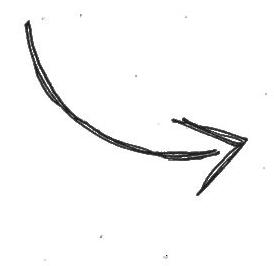
access visual art in the first place.
The majority of the $286 million is yet to be spent or allocated to specific projects—the policy has a long way to go. However, reforms that recognise the political potential in the arts, albeit not always a radical one, will better entrench arts funding and the role of creative professionals in the economy. Further, a more consistent, public acknowledgment of the arts industry’s economic worth will hopefully insulate them from the neglect and abuse of future pandemics and economic turndowns.
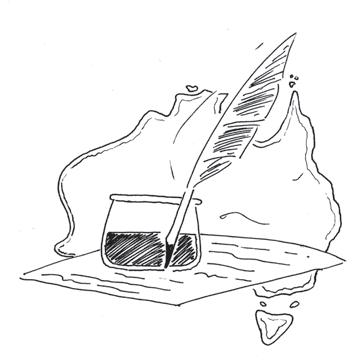
Medical Expenses: The cost of prescription medications, over-thecounter remedies, and specialised treatments for migraines can quickly escalate. With daily migraines, I often find myself relying on various medications to manage symptoms, which can strain my budget, especially on a student income.Neuromodulation devices like Cefaly and gammaCore cost over hundreds of dollars a year, with the Cefaly at $499 flat, then around $60 every few months, and the gammaCore at $300 a month;
Neurologist Appointments: Monthly visits to the neurologist are essential for monitoring my condition, adjusting medications, and exploring new treatment options. However, each appointment comes with its own set of expenses, including co-pays, transportation costs, and potential lost wages from missed classes or work;
Lifestyle Adjustments: Living with daily migraines often requires making lifestyle adjustments to manage triggers and minimise symptoms. This may include investing in ergonomic furniture, purchasing special eyewear, or modifying diet and exercise routines, all of which come with their own financial implications. The Avulux frames cost me over $900 and the Theraspecs frames were $150;
Lost Productivity: Migraines can significantly impact my ability to work, study, and participate in extracurricular activities. Missed classes, deadlines, and opportunities for part-time work result in lost income and disadvantaged educational opportunities, exacerbating the pressures of financial strain.
Additionally, the impact of chronic health conditions extends beyond the individual student to their families. Many students rely on familial support to cover medical expenses not covered by Medicare subsidies. This places added pressure on already stretched household budgets, further highlighting the interconnectedness of health and financial well-being.
So, what can be done to alleviate the financial burden faced by students with chronic health conditions? Firstly, there is a need for increased awareness and understanding of the challenges these students experience. University administrations and policymakers must recognise the unique needs of those under the National Disability Insurance Scheme (NDIS) or experiencing chronic health issues and implement support systems to address them.
There is a pressing need for improved access to affordable healthcare options for students. This could include expanded health insurance coverage through universities, increased funding for student health centres, and greater access to mental health resources to address the psychological toll of chronic illness.
Additionally, universities can implement flexible academic accommodations to support students
“ what can be done to alleviate the financial burden faced by students with chronic health conditions?”

managing chronic health conditions. This may include flexible attendance policies, extended deadlines, and access to alternative learning formats to accommodate periods of illness.
As students, we must also advocate for ourselves and each other. It is no small feat in managing the complex web of issues that orbit dealing with chronic health conditions as a student. And we know Medicare and current structures are not enough. The financial strain, coupled with the demands of an academic and working life, creates significant challenges for students navigating chronic illness. By sharing our experiences, raising awareness, advocating for change, and implementing supportive measures, we can work towards creating a more equitable and inclusive university experience for all students.
“You are too smart to be a teacher”: Teaching and the social demonisation of public servants
Angus McGregor questions our faith in public education.
Note: All teachers and employees at the Department of Education quoted in this piece chose to remain anonymous due to rules restricting unauthorised conversations with the media. Students, to protect their privacy, are also quoted without names.
Addressing a crowd of supporters in 2008, Vice-Presidential candidate Sarah Palin was asked if she supported raising teacher pay and benefits. The response — “her reward is in heaven”— is emblematic of the dehumanising rhetoric educators face in the public discourse of almost every Western liberal democracy. While Australian politicians are not quite as blunt as Palin, teachers in Australia are almost constantly blamed for the failures of the education system alongside being demonised as radicals who act as a symbol of state influence on children.
Whether it be the former acting Education Minister Stuart Robert calling the ‘bottom’ 10% of teachers illiterate during the Morrison government, or former PM John Howard claiming teachers “abused their positions” by using the classroom to discuss an opposition to the Iraq War, teachers have for decades been the target of choice for conservative politicians suspicious of public institutions. The political associations of teaching with unionism and socialism date back to the early 20th century. Laws in Australia banned teachers even mentioning concepts like communism and atheism across the 1930s and 1940s. Those wars are still present. The fights over the ANZACs and Frontier Wars continue in classrooms today.
Being a traditionally femaledominated profession since the adoption of public education in the early 20th century, only 22% of current NSW schools teachers are men, teaching has also suffered deeply held misogynistic assumptions that classify female work as less intellectual or not worthy of praise at all.
More impactful, however, is how those wider political battles over who teachers are and what they believe erode society’s trust in the value they bring to society through public education. After talking to teachers, academics and students across many weeks, it became clear the structural reform required to fix chronic shortages, casualisation, and by extension workloads cannot occur without a national shift in how we perceive teachers and the intellectual nature of the work they do.
There is no question public schools are currently in a crisis. Almost 30,000 full time staff have left the system since 2010, citing terrible workplace conditions and some studies show the average public school teacher works an average 60.1 hours a week as opposed to the full time workload of 40 hours they are contracted for. There is currently a daily shortfall of over 3,000 teachers in NSW.
For every teacher that leaves, the mental and professional burden on the rest increases dramatically. About 60% say they are planning or considering an exit in the next five years.
One teacher from Sydney’s Inner
West told me “quitting is a daily conversation in the teachers lounge.” Another agreed saying “everyone these days has a clock in their mind… just waiting for the right time to step out.”
Empirically, the structural problems facing schools have nothing to do with teacher performance. NSW public schools are only funded at 89% of what they are supposed to be under the Schooling Resource Standard (SRS) as of January 2024. Due to shortages, teachers are having to regularly plan and teach subjects outside of what they have been trained for. The after effects of the pandemic, which had profound consequences for the social maturity and mental wellbeing of students, have also caused a spike in behaviour issues which include a 34% increase in assaults and other violent behaviour on school grounds since 2021.
Anyone who expects teachers to function, let alone thrive, in that environment is delusional — yet that is the dominant exception in the Australian media and public. A study by University of Sydney Professor Nicole Mockler on over 65,000 print and digital articles covering teaching between 1996 and 2020 found that in 2012 “teacher quality” was mentioned at a rate of 149 words per million while “education quality” was mentioned at a rate of only 58 words per million. Because they are the face of education, the structural issues facing the system are mapped onto teachers.
“Quitting is a daily conversation in the teachers lounge.”
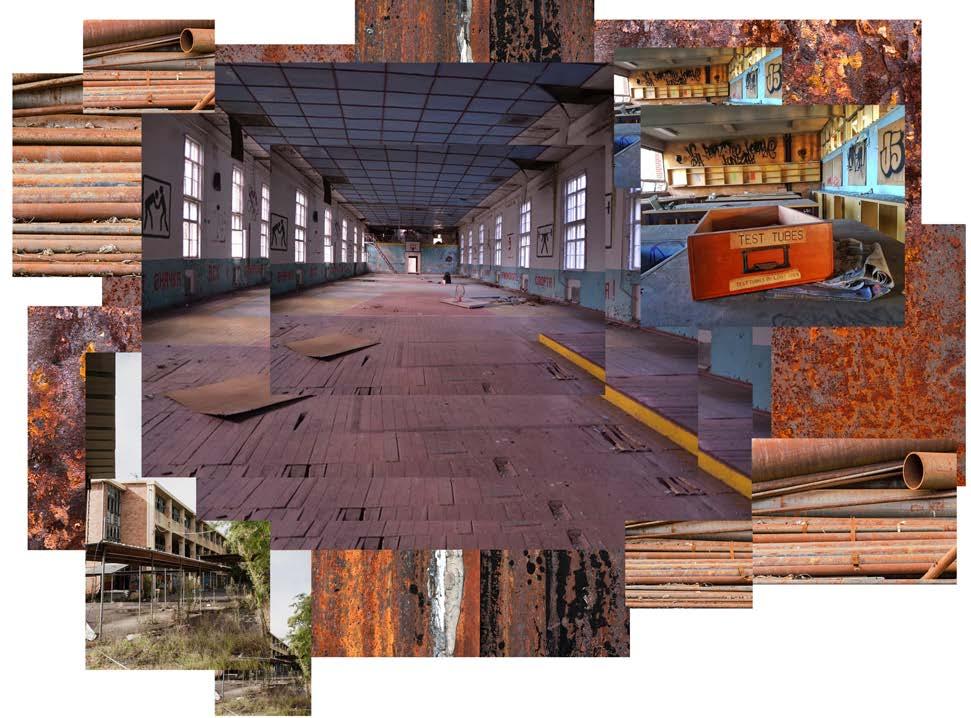
This manifests itself in uncomfortable confrontations with parents on the ground which the articles highlighted above only self-perpetuate. Only a small number of adults would question what painkiller a doctor gives them or their children but thousands of parents in Australian classrooms will pick at every choice a teacher has to make. Teachers across Sydney told me parents have questioned them about their teaching styles, disciplinary methods, and even the content they
teach and what order to teach it in.
One teacher with over 15 years’ experience in the public system summarised it well: “there is this constant idea that because you went to school as a young person, you are an expert in education.”
The wider policy implications of a media narrative dominated by teacher quality are staggering. Attempts at attracting teachers with incentives or improving teacher ‘standards’ as a basis for increased outcomes in the classroom has dominated federal reform for 20 years.
During the Gillard and Rudd years, postgraduate teaching degrees were lengthened and new HSC requirements for Education degrees such as minimum results in English were introduced. Former PM Malcolm Turnbull continued the trend by introducing the Literacy and Numeracy Test for Initial Teacher Education (LANTITE) in 2016 after education ministers approved the plan in 2011, which every teacher education student has to pass to gain accreditation. There was a clear link between improving the ‘standards’ of teachers and improving the results of students. Even the NSW Teacher Federation bought into these shifts to some extent arguing in reviews that “there is a clear downward trend in the academic attainment of students entering initial teacher education,” or pointing to the fact that in some cases “less than 60% of students complete their course after six years.”
While it is politically impossible to argue with higher standards for teachers in the abstract, the question is irrelevant if teachers cannot do their job. Not seeing any improvements in the shortage since the rise in standards, current Education Minister Jason Clare has flagged the return of one year post graduate degrees to “fast track people into the profession.” There has been a complete flip from creating the ‘best’ teachers to filling spots in classrooms.
Dr Claire Golledge, the coordinator of HSIE Curriculum at the Sydney School of Education and Social Work at USyd, told me that while there was a tension between getting teachers to fill positions and making sure they were adequately prepared the current seesaw was “crappy policy”.
“You cannot have your cake and eat it too,” she continued, arguing governments can always tweak standards as a quick way to signal initiative. The cost is relatively low and adding or cutting content from syllabi is simple.
The premise behind streamlining education degrees, while politically fashionable, further takes away from the intellectual elements of teaching. Current estimates show that the average teacher makes over 1,500 professional decisions a day. Beyond making
active choices about how to shape a complex and fast paced curriculum to sometimes up to 30 students from every walk of life, teachers are required to be professionally empathetic. Every problem students have at home manifests itself at school. Teachers have to be experts handling students struggling with mental health issues, abuse, anti-social behaviour, poverty, or just having the normal range of emotions teenagers all have.
“There is this constant idea that because you went to school as a young person, you are an expert in education.”
The narrative that you can just be thrown into a classroom earlier and learn on the job or through observation is appealing, but handling these issues requires a deep understanding of psychology and the social and environmental factors that influence behaviour. This is before you even get to the subjects themselves which teachers have to not only master but be able to communicate in a variety of ways depending on the class they get.
How do you teach Shakespeare to a class with fluent English speakers and with those who speak English as a second and third language?
How do you teach a colonial Australian history curriculum to Indigenous students or recent migrants?
These are not questions that can be answered on the job. No politician would ever advocate the shortening of law or medicine degrees, even if there was a major shortage. You would never insert an IV or walk into a courtroom without years of training. For those professions and others, knowledge is seen as a prerequisite for the job. It is frankly shocking that teaching is not seen as an equivalently rigorous profession, especially considering they spend longer with people in their most formative years than any other group of people.
When young people seek an interest in teaching the profession is not framed as an intellectual challenge or a rewarding intellectual discipline but rather quite the opposite. Over ten students I talked to across their degrees told me they were told at various points by parents, friends, and even their own teachers, “you are too smart to be a teacher…” or “you could do so much more.”
Teaching is the one of the most popular occupations students aspire to in primary school and younger years of high school in Australia, however by the time students reach later years, teaching drops below almost every other profession in terms of its desirability.

The government is aware of the problem. In one submission to a parliament enquiry on the teacher shortage, academics told members they had to “work with media organisations to establish understanding of the vital role of teachers in creating and maintaining a vibrant, democratic society.” Advertising campaigns have been funded for years that are supposed to raise the reputation of the profession. The emphasis is often on “making a difference,” with every lesson presented as an opportunity to change a child’s life for the better. The ability to bond with students is important to highlight and as Dr Golledge points out ads like these push back against the “teacher bashing” in the media.
However, the shame of these advertising campaigns is that they mirror the narrative that teaching is something you do because of the passion you have, despite the challenges in the profession, and despite pay and conditions. This is somewhat a necessity due to the current state of the profession, but governments have to stop being defensive and fight for teachers publicly, not just in Department advertising but in parliament and during elections.
Universities ironically like an emphasis on standards because it plays into the marketing tools they use to present degrees. The chair of the most recent teaching standards review was Vice Chancellor Mark Scott. The review aligned itself with streamlining teacher education by introducing socalled “core content” to all degrees. When Labor was talking up standards a decade ago, universities pushed their new master’s degrees advertising the longer degrees better prepared teachers for emerging challenges in modern schools. Now, the new four year Bachelor of Education has replaced the five year double degrees in order to, in the words of USyd Education spokesperson Eddie Woo, “get teachers into the classroom faster.”
The obsession with teacher quality at the federal level also stems from the government’s increasing lack of control over the sector. Funding, workloads, and the other systemic issues are within state jurisdiction but the government in Canberra cannot just pass the buck. Every academic and teacher I spoke to expects the fixation with quality and standards to continue.
At the state level, the Minns government has made some valiant progress since their election last year. The historic pay deal reached with the union in September raised starting salaries to almost $10,000 to $85,000 and top of the scale teachers now make $122,000 a year. The $400 million
Education Future Fund will push public schools closer to full SRS funding and hundreds of new pre-schools are being constructed.
Even with some change coming, students studying education at USyd empathised how demoralising the emphasis on teaching quality was. One said, “we always hear about low entrance scores to get into teaching. We always hear about teacher underperformance.” There is no other major profession where students have to read headline after headline telling them they are inadequate before they even step into the role. “It makes placements so stressful,” one second-year Primary Education student told me. “No matter what marks you get, there is a deep sense you are not ready.”
Almost every student mentioned paid placements repeatedly as the best thing the government could do to make teaching more attractive and sustainable. Over 80% of Education and Social Work students report adverse mental health pressure from the financial pressure associated with weeks of unpaid work. Examining placement poverty at the university level quickly displaces myths that standards are the issue. Teacher education students are not completing their degrees at lower rates because they are not ready for the job, or because the entrance marks are too low — people leave early because they have no other options.
“I know maybe two or three — maybe more — friends who have changed degrees or dropped out early before or during a large prac,” a thirdyear student told me.
Paying for placements and further incentives like the government footing the HECS bill for teacher education seem likely in the coming years. Victoria introduced a $229 million package last year which paid for the cost of teacher education degrees. One employee at the Department of Education signalled that this was already causing some NSW students to move, arguing the NSW government would likely have to follow suit to prevent more bleeding.
“I know maybe two or three — maybe more — friends who have changed degrees or dropped out early before or during a large prac.”
At the end of the COVID-19 pandemic, over 80% of parents said they had newfound respect for teachers after attempting to make up for the shortfalls during online learning. 67% think the job of a public school teacher was harder than their job. As a society we need to leverage our momentum to shift the narratives that blame some of the hardest working public servants for our own failures. More material reform can only happen if we truly believe the work they do is worth the billions required to fully fund school and fix the shortage.
When someone next tells you they are considering becoming a teacher, don’t question if they are suited for a more proper job — but also don’t smile as if they are taking on a burden you would rather ignore.
On the policy front, one student asked me at the end of our conversation if by the time they graduated in three years it would get any better. I did not know how to respond with any form of optimism. Even governments with good intentions and a wide mandate will take years to structurally reform the system. Constructive narratives that elevate the reputation of teachers while not placing the burden of education solely on them will allow society to shift away from marginal discussions based on standards and refocus on creating an environment where they can reach their civic and intellectual potential.
out.
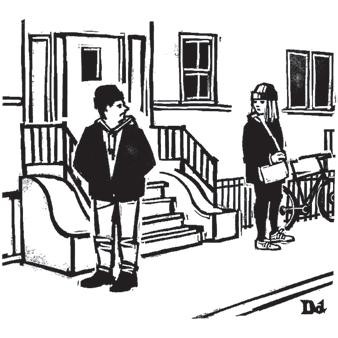
Since February 21, 1925, The New Yorker has developed a strong tradition of peppering 18 to 24 cartoons throughout its paper. The comics may be diverse in style and voice, but have come to fuse as one to define The New Yorker’s style. From this convention, a cloister of cartoon acolytes has sprung, many of whom fiercely enter the magazine’s Cartoon Caption Contest each week. Although many publications shut the door on cartoonists, The New Yorker has remained a safehaven of graphic slivers. To be published in its pages is a phantasmagorical dream for cartoonists worldwide.
But who is behind the pen for many of these legendary cartoons? I sat down with Drew Dernavich to discuss life as a wry and witty cartoonist. His cartoons are at the heart of The New Yorker, featuring distinct, bold-lined drawings paired with acerbic captions.
An essential ingredient of a cartoon is the drawn image. Drew shared that he’s been “drawing ever since he was little”, initially dreaming of a painting career. “I was introverted, so as I was a child I would stay inside and draw,” Drew said. “I often stayed
inside drawing the things other kids were doing outside, such as practical jokes.”
He began to envision a career in cartooning after making cartoons for the school newspaper; his high school art teacher also dissuaded him from attending art school. “I thought it would be easy,” Drew titted, “but I found my sense of humour was terrible.” He discovered that drawing was only one element of cartoon craftsmanship.




Composing a cartoon requires a delicate balance of capturing the human experience and injecting it with surrealist wit. To brainstorm, Drew consults a variety of sources: magazine, fiction, real-life situations, an internet random noun generator. “There’s no strict formula or magic to it,” Drew shared. “You have to keep pushing it. It requires handwringing.”
When asked what makes a ‘good cartoon’, Drew offered some tips: the caption should be as short as possible, and should avoid explaining the joke. The situation should also be “topical, really funny, and really surprising”, and “reaffirm something you know”, whilst preferably working on multiple levels.
To budding student cartoonists, Drew advised, “Don’t imitate a certain publication’s voice!”. Many aspects of a cartoon contribute to its voice — the brushstrokes, caption style and humour. Each New Yorker cartoon I’ve encountered is a fingerprint, telling different stories with different tools.
One of my favourite cartoons by Drew adds an absurd twist to the reality of U.S. elections becoming popularity contests, displaying Shen Yun and Michael Bloomberg going face-to-face in the Presidential debate. Another beloved comic parodies the
social phenomenon of “cuffing season” alongside the biological “flu season”, prompting chuckles as we muse on our collective experiences, illnesses or otherwise.
Drew has been a consistent contributor to The New Yorker since 2006, but his career undeniably required blood, sweat and tears as well as brushes, sketchbooks and tables. His tale of persistence entailed a “long period of trying and failing”, where he sent cartoons to The New Yorker for three years. He also submitted cartoons to other publications, but he found that media platforms often opt to fill blank spaces with advertisements rather than slices of entertainment, shrinking available publication opportunities. After several years of putting his nose to the grindstone, Drew took a pause and returned to a season of regular submissions with a refreshed style.
Drew’s perseverance paid off, and he did not lose steam at first sight of success. He follows a routine of devising ten ideas every morning. Then, as he stews on these sunrise thoughts, the power of time reveals which are genuinely funny. “I then submit ten cartoons to The New Yorker”, Drew said. “It’s quite a subjective process, so I am not always certain which one will be chosen.”
Drew chuckled as he regaled an anecdote where he submitted a cartoon to The New Yorker that he didn’t fully understand, and was shocked when the editor selected it. Later, the editor asked him what it meant, prompting them to realise that neither of them grasped its meaning!
On crises seizing the media landscape, Drew is somewhat pessimistic. “I refuse opportunities
“What’s your favourite colour?” is a very decent question.
Any person under the age of ten knows this instinctually; it’s part of a social code. “Your favourite colour’s blue? Mine too!” Thus begins a prosperous friendship.
“Turn to the person next to you,” Mum said on my first day of kindergarten, “and ask them their favourite colour”. This sounded like a grand plan to me. So much of our exterior identities could be wrapped up in these shallow signifiers. If I could know that Claudia B on my table liked the colour green, I could tell you I knew her and that she was my friend.
I still remember some of these preferences, and that strikes me as peculiar. My best friend liked blue, my ‘crush’ favoured orange. My favourite was pink, I told them, because of the bougainvillaea planted outside

my bedroom. Nothing to do with my hunger for sparkly plastic.
Things haven’t changed much. You might not exchange favourite colours in first tutorials, unless as part of a gruelling ice-breaker, but you’ll probably see the Doc Martens-wearers all huddled up together. I can’t help but ask if there’s a social significance. Is this why we all wear bows now? Selfexpression is a strange thing. We are tasked with the challenge of conveying our strangeness in exactly the right measure, through exactly the right
to teach cartoon classes”, he said, “because I fear there’s no career in it for others.” Publishing space for cartoons dwindles as the media is greedy for advertisement revenue, and “it is hard to make a living as a cartoonist”.
However, Drew is less nonplussed about Artificial Intelligence (AI) than many of his contemporaries. “Many of my friends are quite worked up about AI”, he said, “but to me, it’s just another media crisis, it’s just part of the media apocalypse.”
“It’s hard for AI to capture the essence of a good cartoon. Laughter comes from surprise, things that take wrong turns, non sequiturs. The inherent feature of AI is that it is derivative — it averages data and imitates style — everything that a good cartoon is not.”
Though I don’t have any cartooning experience, I’m holding onto hope that the crises facing cartoons and their beloved creators are short-lived. The simple fusion of illustration and caption has the power to bring us together and make us laugh, reminisce or return somewhere forgotten. Carving out space is the least media platforms can do to give these squaresized salves a home.
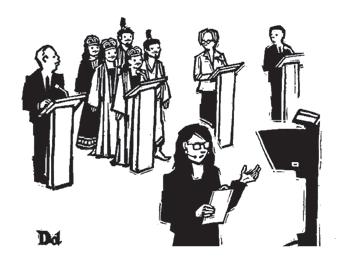
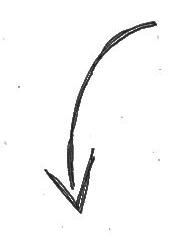
 Art: Drew Dernavich
Art: Drew Dernavich
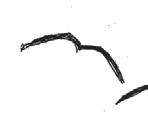
lens. Hopefully, you have a strangeness common enough to find someone who is strange in just the same way.
Loneliness encroaches on our generation like a shadowed spectre, and vast access to niche media pockets has exacerbated social gaps. The Australian Institute of Health and Welfare says an increasing number of young people experience loneliness. Some University professors seem to think that all students need to do is open a crayon box and share their favourites. “I like the purple because it reminds me of the Quad’s jacaranda.” “Really? Red’s my favourite. It reminds me of the ‘DANGER’ asbestos signs!”
I have this friend, Tom, and his favourite band is Pixies. At least, this is what the tee-shirt he wears to Room 402 every second Thursday when his laundry cycle repeats says to me. He wears moc toe boots and talks a painful
amount about late-stage capitalism. I sit behind him in Room 402, a little to the left. I like the Pixies too. So says the sticker on my laptop. We share a nod: to his shirt, to my laptop. In a way, we have the same favourite colour.
I still feel like a bewildered sixyear-old, stretched out into a big kid’s body — and yet I defend the business of small-talk and other banalities. I believe in “What’s your favourite colour?” There’s no better way to fasttrack a friendship than volunteering extraneous details. Chances are, the person at your table this semester might not be your soulmate. But you could sit a little more comfortably knowing that neither of you is alien.

If I tell you I think pink is my favourite, will you be my desk buddy all semester-long?

Gabrielle Woodger is worried for the future of cheese.
We gather here today to celebrate the life of cheese.
For me, some of my fondest memories are of cheese — on pizza, tacos, pasta, sandwiches, toasties. I cherish the moments I’ve had with Brie and Camembert on charcuterie boards, paired with prosciutto, strawberries and Jatz. Beloved by many, the death of cheese is a great shock.

manufactured cheese] has become extremely impoverished.”
Not only that, different cheeses are suffering from different issues.

Well, technically speaking cheese isn’t dead, but according to the French National Center for Scientific Research (CNRS), it certainly is in danger.


First, let’s take a moment to reflect on cheese’s childhood. During the production of cheese, milk is separated into curd (milk solids) and whey (the watery stuff left over). Cheese is made when the solid curds are injected with bacteria and/or fungi. But growing up in a world of standardised food production has been hard for cheese. For years manufacturers have selected and genetically reproduced strains of fungus and bacteria to meet strict specifications. The CNRS says that the food industry has “exerted so much pressure on the selection of fungi that the microbial diversity [of
Blue cheese’s life has been plagued by health problems. The famous bluegreen mould comes from the use of Penicillium roqueforti fungus in the fermentation of all blue cheeses. There are only four populations of it known to the cheese world. After using the same strain for decades, the genetic diversity of P. roqueforti has been drastically reduced. It has been asexually reproduced and cloned to such an extent that the strain is becoming nearly infertile due to the accumulation of genetic defects.
However, it is Brie and Camembert
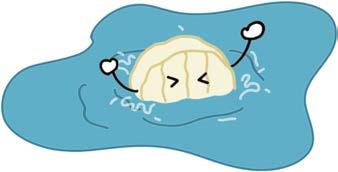
who have struggled the most. These cheeses are made from just one strain of the fungus Penicillium camemberti,
Zeina Khochaiche flicks through Vertigo.
Next up, our neighbours.
Located only a 19 minute walk away from University of Sydney’s Darlington campus is University of Technology Sydney (UTS) — a university distinct for its skyscraper terrain, à la mode fashion style, and irreplicable student culture. Should you find yourself in one of the many buildings across UTS’s campus or scrolling on Instagram reels, you might also find their student magazine, Vertigo This is instalment two of our student media spotlight, an opportunity to learn about the breadth and brightness of the Australian student media landscape.
Vertigo was born in March, 1973 and recently celebrated its 50th birthday last year with its cardinal editor, Ross Gittins, amongst the panel of alumni reflecting on its lifespan. On behalf of Honi, I was lucky enough to attend the event from which began my interest in the cool and fashionable magazine just down the road. Regardless, modern day Vertigo is, comparably, still a baby. But its late-20th-century inception has not stifled its impact on student journalism.
Vertigo was actually born as Newswit, an iteration of UTS’s predecessor institution, NSW Institution of Technology,with the vision of publishing a ‘by students for students’ newspaper. The scope ranged anywhere from the Vietnam War to workers against the anti-strike laws. But as the years stacked up, so did the institutional pressures of upholding a student publication. The NSW Institute of Technology became
UTS in 1988 and, after only a few silent years later in 1991, Vertigo magazine was born. Interestingly, the name, Vertigo, is an homage to the campus’s iconic brutalist building, UTS Tower, which can cause the sensory dizziness of vertigo for those standing at its peak.
So from a political newspaper to temporarily non-existent and now a pillar of student culture, Vertigo has had many lives — I’m confident it will be a while before we have seen their last.
To better understand the fabric of Vertigo and its layering within the UTS ecosphere, I sat down with Ty Seeto and Mia Rankin who made that 19 minute journey down to the Wentworth dungeon. Ty Seeto is Vertigo’s 2024 passionate Editor-in-Chief, responsible for the “orchestrating” of this year’s vision, exploring the depths of student politics and leading team of 12 editors. Mia Rankin is Vertigo’s Arts and Culture editor, informed by their innovative work in Zine-making and nuanced taste for the music and theatre scene.
Vertigo now publishes a mixture of print issues, online articles, podcasts and video media. When asked what the magazine’s strongest appeal is, Rankin described a vision of an “open and accessible” space in which students from “any discipline can produce work they are proud of.”
Echoing this and referencing the diversity of voices and students they platform, Seeto said, “it isn’t right for a student publication to ignore a large part of the student populous” and told Honi that “Vertigo is a space for
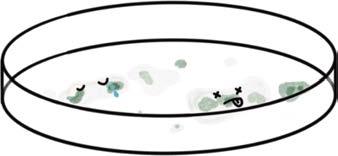
which can only be replicated by asexual reproduction. Furthermore, the white-rinded Camembert known today is produced solely on one albino strain of P. camemberti which cannot be found in the wild. It has been overproduced to such an extent that this strain has been rendered incapable of both sexual and asexual reproduction. The CNRS warns that industries are already struggling with the ongoing production of Brie and Camembert, with some cheese makers supplementing P. camemberti with a different fungus altogether.
In reality, it is unlikely these cheeses are going to completely disappear from supermarket shelves, despite a possibility of minor blue cheese, Brie and Camembert shortages. And there is much hope: a little-known French blue cheese, Termignon blue, has been created from a previously unknown
population of P. roqueforti. This could introduce more genetic diversity into all blue cheeses. The solution for Brie and Camembert is slightly more complicated. Some have suggested the introduction of genome editing technology to remove mutations in P. camemberti, and others have suggested introducing genetically related species of fungus. Either way, the CNRS suggests that if we want to continue enjoying these cheeses, we will need to “appreciate greater diversity in flavour, colour and texture” as manufacturers adapt their traditional cheesemaking methods.
So let’s farewell cheese as we know it, and prepare to welcome a new generation of cheesy goodness.
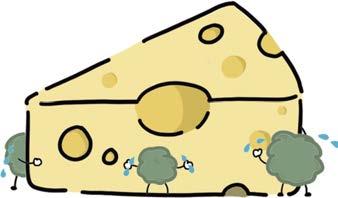 Art: Regina Wu
Art: Regina Wu
everyone.”
Whilst in reference to ‘spaces’, Vertigo has had a challenging time keeping their own office space after it was reallocated to another student group at the end of last year. With a strained giggle, Seeto revealed that the Vertigo team “has been camping out at the activist space” and has had inconsistent access to their equipment but have still fought to produce quality media for their students. Unfortunately, the perils of funding cuts and complex relations with University of Technology Sydney Student Association (UTSSA) yet again place student media in a pressure cooker, with further budget reductions expected to be introduced this year.
Seeto remains hopeful for a constructive future and said that their “editorship will work to build a good relationship with UTSSA in the interest of preserving student media.”
Cutting through the fatigue of funding talk, Rankin reminded that student media is a rare platform to showcase the art that students invest their energy into, feeling “proud” that they are part of a magazine that can facilitate this. UTS is renowned for its talented design faculty and curated student culture that can neither be overstated nor overlooked — not to mention their not-to-be missed fashion content on Instagram reels and TikTok.
Despite a recurring sentiment that Vertigo has been stifled by factors and
circumstances out of their control, our discussions always circled back to the students. Seeto and Rankin embody their magazine’s ethos of “made for, run by, and in the spirit of UTS students.”
It’s this unyielding dedication to platforming a diversity in student voices despite what mainstream media may make convention, or what finance reports institutions may dish out, that makes Vertigo such a valuable neighbour to us and magazine to all.
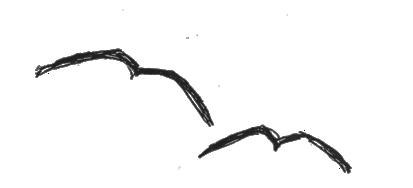


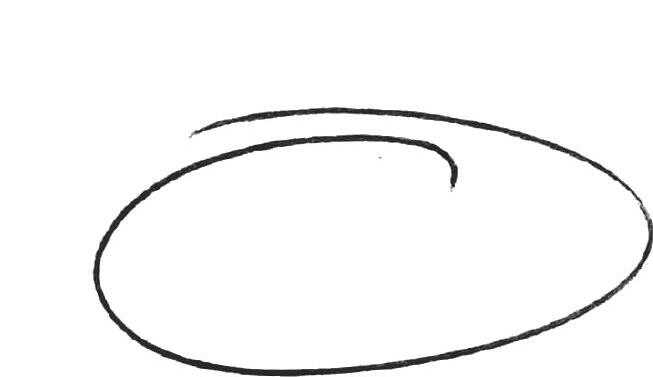
Zeina Khochaiche prints some posters.
From Pompeiian electoral propaganda inscribed in walls and tablets, to Benjamin Franklin’s ‘join or die’ proto-poster, to Toulouse-Lautrec’s first lithographic Moulin Rouge, to the contemporary ‘keep calm and [...]’, the artform of postering is an unmistakable signifier in anthropology.
The paper poster supposedly dates back to the late 15th century with William Caxton — an Englishman who introduced the printing press in Brugge — which included the first advertisement poster listing the benefits of thermal waters in 1477. However, it wasn’t until the birth of lithographics and the flourishing 1880s French art scene when a leap in postering occurred as an accessible medium of communication.
Lithography can be defined as the process of printing a graphic or signifier on a flat surface — the modern poster. The poster is a medium of visual communication which transmits graphic images and textual signifiers, forming a historic, universal and expansive language. Parameters of postering include vantage sites, timing of mounting, and of course, the messaging. University culture, in particular, has adopted the form of postering to communicate with fellow students.
Fast forward to the grey pavements of Eastern Avenue: postering and flyer handouts have become synonymous with the student experience at the University of Sydney. Students on campus have been constantly pasting the walls and halls with posters descending from the likes of fanatical student politicians, eager University of Sydney Union (USU) clubs, self-proclaimed anarchists and hopeful revue promoters since the university’s inception in 1850.
The Tin Sheds gallery, USyd’s contemporary exhibition space for the School of Architecture, Design and Planning, has historically been the archive for USyd’s poster evolution. Now the University of Sydney largely manages the poster archives but it still holds a mirror to the tropes and social structures that permeated student culture at the time of circulation.
Posters have historically served as a valuable messaging format for student safety reports and activist updates. For example, Tin Sheds houses posters of student activist media such as “SEXUALLY HARASSED?”: USyd’s Sexual Harassment Committee poster by Jean Clarkson (1984).
Similarly, community cultivation and unionbuilding efforts amplified their work through posters. This evidenced in “ARTWORKERS” general meeting from the Lucifoil Poster Collective poster advertising the 1981 Artworkers Union Annual General Meeting by Leonie Lane.
Student politicians and student groups have always built community and momentum through posters. Back in the day, snarky subtweets or Facebook comment essays took the form of papering over other faction posters and strategically combating each other’s slogans. Now collectives use posters to build interest in rallies, speak-outs, collective events and protests, as well as advertise their group’s ethos.
Mostly gone are the days of political persecution with postering wars. Harrison Brennan, the 2024 SRC President, tuned in to discuss the changing role of postering around campus. Today, when students arrive on their first day of university, they are met with an overstimulating barrage of rally promotions, ambiguous socialism conferences and student collective call-outs layered over City Road Bridge and coating the boards of Eastern Avenue.
Leading the conversation with an evaluation of current postering efforts, Brennan confessed the student practice “is in no healthy state,” mentioning that “the clubs and societies posters can feel a little bland.”
Despite this, Brennan acknowledged that despite the fact postering has “died for many, it is not dead yet” noting that its function is “building community engagement” that surpasses the contentious borders of student politics or stagnant club gatherings. The practice and design has been increasingly informed by the 70s-90s epoch with archival inspirations, parodies of past slogans and bold collage art leading the trends. When referencing postering in contemporary student politics, Brennan said “our posters are always antithetical to management.”
Today, posters around campus are used to promote rallies, entice audiences to attend revues and advertise campus happenings. Ishbel Dunsmore has been a recent voice in poster design who has leant in to the parody of USyd management copy. Dunsmore’s posters play on war propaganda and appropriate USyd management’s advertising material to promote student activist initiatives. Brennan said “posters used to litter the entire campus” but noted the only remnants of poster chronicles are the “Trotsky group battles” on the Taste Baguette notice board in the Law Annex.
Now posters must only be mounted on designated poster boards, or they risk removal by USyd management. Common poster boards are found at Eastern Avenue stands, Taste Baguette, the walls of the Education Building or behind the toilet cubicle doors of Fisher Library. Brennan said that despite the designation of spots, he has noticed that “Palestine posters [are] being taken down by the conservative clubs and campus security guards” from bus stops and Eastern Avenue boards.
A spokesperson for USyd referred Honi to their existing ‘Advertising on Campus’ policy, and told Honi that “we don’t remove posters from our designated spots on campus unless we consider them in breach of our policies, charter or codes of conduct; we respect this as a form of free speech and take action against wilful attempts to damage or remove posters if it is done to inhibit another person’s right to free speech.”
In recent times, USyd management has been more decisive with their implementation of policy: “we also have noticeboards reserved for official University notices. We remove non-University notices from these boards, so that our information for students is able to be easily accessed.”
Regardless, postering has taken on new formats with the advent of the Information Age and emerging social media battlegrounds. Even though the era of ‘sensational poster drops’ has been stowed in the attic, stylised infographics and visual call-outs now fill our Instagram stories instead of our poster boards.
There is no question that contemporary poster-making pulls from and appropriates the past to successfully convey messages to our student populace today. Both in its generation, output and consumption, postering is a communal activity and backbone of campus communications. So despite speculation that postering may be “stale” or “dead” the spirit of postering is alive and fighting to be well. Instead it is manifesting in different mediums, paying homage to its iconic, lithographic history whilst looking to the future of visual communication.




There’s no ‘nation’ in ‘museum’ – except, there is
Simone Maddison wonders why.
Like many Australian primary school students, my Year 5 experience was coloured by the highly anticipated Canberra Trip. Settled at the “base camp” of a cheap motel on the city’s outskirts, we spent four days sampling some of Canberra’s delicacies: the National Archives, the Australian Institute of Sport, the CSIRO and an assortment of devon sandwiches stored in our coach bus. Needless to say, the trip back to Sydney paled in comparison to the wonders we had witnessed.
I have chosen to open with this particular tableau for two reasons. Firstly, it represents a stalwart in the Australian youth’s collective memory; there are very few amongst us who would not call this our first time visiting Questacon. But above all, it was an attempt to teach us something about the ‘nation’ and its meaning through public spaces. It was political, not only in its tours of Embassy Road and the High Court, but also in its aim to reinvent the mythology of socalled ‘Australia’ — and to cement us as its proud, fresh-faced and diligent narrators.
The trip itself was, rather obviously, nationalist. But it was only made so through the contents of the many museums and galleries we visited. At first, they were convincing; my UAC preferences were dominated by aspirations to return to Canberra and study politics. Yet as we grow older, and the fresh coats of paint on these public institutions begin to peel, we can no longer hide from the glaring inconsistencies and mistruths embedded in the narratives we tell about ourselves.
In a post-Voice and climatechanging ‘Australia’ built upon the injustices of settler colonialism, white supremacy and capitalism, our generation must now reckon with everything our ‘National Museums’ stand for.
If you were to enter into any of Australia’s 587 state-sponsored museums, you would likely find much of the same content repackaged, reinterpreted and repeated. An exhibition about the landscape of our “Great Southern Land”, similar to that at the National Museum of Australia. An insight into First Nations history and culture, like Yankunytjatjara Wangka! at the South Australian Museum. Or perhaps a focus on AngloAustralian democracy and values, as is highlighted in the Tasmanian Museum & Art Gallery’s Australian Design and Identity Since Federation.
These themes, expressed through different artefacts — but undeniably present in every curatorial decision — are neither accidental nor unsurprising. They have been chosen as part of what Noel Pearson called
the “three pillars of Australian life”, an attempt at forging a ‘national story’ that appeals to everyone in Australia’s ‘diverse’ population and ‘celebrates’ its history.
Nowhere is this more obvious than in the National Museum of Australia’s submission to the Federal Parliament’s Inquiry Into Nationhood, National Identity and Democracy in 2019. In addition to providing visitors with “a sense of belonging, value and agency”, the National Museum recognises the public’s high level of trust for its “impartial and considered information.” Rather than providing the critical voice so many of our institutions need, it has instead resolved to supporting public discussion without “taking sides or settling arguments.” Its priority remains in building “social cohesion and cultural identity in the nationstate.”
One does not have to read this Inquiry in full to feel disappointed and dissatisfied with our museums’ current approach. When I spoke to the University of Sydney’s Professor James Curran about how we ended up in this position, he reminded me that defining ‘nationalism’ has long been a problem in the Australian context. To be sure, only white Australians did have “a powerful sense of nationalism from the 19th century to the 1960s”; they believed themselves to be “one people with a common destiny — and one blood.”
But John Curtin’s vision of Australia as a “bastion of the British-speaking race” in 1941 collapsed alongside the British Empire, leaving the state to lean on a ‘multicultural’ nationalism amidst demographic changes and increased immigration. During our conversation, Curran pointed out that Australia has not fought any great wars or struggles for independence — so, he asked, what is the national story that we should represent in a museum? Captain Cook? Bush rangers and the Centenary Federation? The ANZACs? Diversity?
Many Prime Ministers, historians and archivists have tried, but all have failed to make any of these narratives stick. Yet they remain, as Curran noted, “loathe to let go of the idea of Australia.” We are therefore stuck with the question of the purpose of a ‘national museum’, particularly in a context marred by ongoing physical and epistemological violence, where there is nothing to be proud of or celebrate.
The Australian political landscape is not lacking in examples of an increasingly aggressive nationalism: we are all familiar with the failure of the Voice to Parliament, the state’s obsession with AUKUS and a decade-
long commitment to ‘stop the boats.’ It is no surprise, then, that these feelings — of protecting colonial interests, of rallying around militarism and of desperately attempting to turn it into a ‘national myth’ — also colour our museums.
Recent events have crystallised these issues in new ways. The Australian Museum’s controversy over its Ramses and the Gold of the Pharaohs Exhibition has, in many ways, reaffirmed the dominant definition of the state according to colonial interests and standards in Australia and beyond. Curators came under fire in December last year from the Australian Jewish Association for using the word “Palestine” to describe the location of a battle where “Ramses was second in command, alongside Seti”, claiming that the name “wasn’t invented until thousands of years later.”
Initially, the Museum responded by removing “any non-historical geographic references besides the use of the common term ‘Egypt’” to “avoid confusion and to focus on the story of Ramses himself.” After AFOPA, APAN and Palestine supporters around Australia sent an email to the Museum on December 28th condemning this decision, the Museum updated the text panel to read “Ramses was second in command, fighting alongside Seti I in what is today known as Libya and Palestine” to “provide current geographical context.”
This example does not, as some might say, represent the latest tiff in an ongoing war over history or ‘political correctness.’ Instead, it demonstrates our institutions’ commitment to upholding the power and privilege of the nation-state; and, in turn, erasing the lives, languages and histories of colonised people.
As an anonymous University of Sydney student who works at the Museum put it: “at the end of the day, museums are a medium of public history and thereby are curated with the intention of serving ‘the public’. It raises the question of which ‘public’ the Australian Museum caters for, and how this reflects the core values of the institution.”
While this example does not seem to indicate anything about the parochial ‘Australian’ identity, it does signal a reliance on identity politics in history, to omitting and misrepresenting the uncomfortable sections in favour of something more palatable to the Anglo-Australian ear. The Australian War Memorial, wrapped up in its visions of sacrifice, service and loyalty to what many have experienced as an oppressive ‘nation’, lies at this intersection between whiteness, settler-colonialism and militarism.
When I first visited the War Memorial in 2013, I was struck by its grandeur: the wall of red poppies, the echoing quiet in the Hall of Memory,


and the glistening light flickering from the Eternal Flame to the Pool of Reflection fascinated me as an eleven-year-old. But this is all pomp, pageantry, performance intended to make me feel this way.
The Memorial’s rebranding to “we are young and free” in 2017 not only takes British settlement as the beginning of history, but also tempers what historian Nicholas Brown calls “the facts of conflict and its casualties within [an] apparent innocence.” Digital exhibitions are intended to dramatise war. The whole thing is, as James Curran and I also discussed, “nurturing a spiritual chain of memory for white Australians back to their ancestral forebears.”
That definitive moment has never existed. I suspected so much in Year 5, and I know it now. Of course, this is not an exclusively ‘Australian’ issue. Upon a recent trip to Singapore and Malaysia, I was continuously struck by the large groups of school-aged children descending upon their own national museums. Clad in paper-white tunics and the wry grins of missing school for a day, they diligently copied ‘official histories’ onto their activity worksheets.
Herein lies the fallacy of what many Australian museums have embraced as the allegedly ‘challenging’, ‘countercultural’ or ‘controversial’ exhibition. Some of the nation’s most notable exhibitions are avowedly ‘activist’ in their purpose and content: the Australian Museum’s Burra, Melbourne Museum’s Unfinished Business and our very own Chau Chak Wing Museum’s Tidal Kin are all doing important cultural and intellectual work to contest Australia’s official narratives.
Yet the extent to which this is genuinely decolonial work must be problematised. As political scientist Sarah Maddison points out, Australia’s “record of historical injustice” implicates a “guilt about the past” in its construction of national identity. Australian nationalism is perpetuated as a kind of ‘settler-nationalism’, one which is inseparable from the relationship between colonists and First Nations people, and which defines land ownership as the nationstate’s main identifying feature. In many ways, these exhibitions represent a co-opted narrative of Australia as a ‘post-colonial’ state.
So, the museums remain white and sanitised, and the schoolchildren will continue travelling to Canberra to visit them. We may not remove the ‘nation’ from these public institutions, but we can certainly change its meaning. Perhaps we will finally have a history written not by the state, but by ourselves — and one which we’re not afraid to tell the truth about.
Ariana Haghighi finds skeletons in the closet. USyd is famed for its colourful revue season. The tradition of some revues, such as Law or Science Revue endures, but as with anything on campus, time works change. Many Revues have jumped into the spotlight and since faded into obscurity: Hack Revue, Jew Revue, International Revue and Education Revue are few among a starstudded cast of extinct spectacles (for now).
The impact of COVID-19 on campus life and student theatre may be a tired discussion, but it is undeniable. The absences of so many identity and faculty revues are loud, and speak to dwindling participation due to the ‘COVID gap’, where the time lapse during lockdown meant experienced students graduated and could not foster novice involvement.
The first Revue held at USyd was known as “USYD Revue”, but quickly branched off into faculties, and later, identity revues. In 2013, USyd Revue became a “Best Of” assortment of sketches from the year before: initially, it played as part of the Sydney Comedy Festival.
I spoke to 2019 USyd Revue Director Kate Walder, who was contracted by USyd as a professional director to work alongside student
anatomy
producers and cast members. She was tasked with combing through the material of all 2018 Revues, and pulling together the best and brightest sketches.
That accounted for 50% of this ambitious “Best of” project. The other half of the show was devised exclusively by the USyd Revue cast of that year. Walder selected the cast from a pool of not only USyd students, but students from other universities. “I was very conscious of having representation from each revue”, she said.
The USyd Revue rehearsal process was longer and more intensive than the average identity or faculty revue. In Walder’s year, they had three rehearsals a week over a period of four months, wherein there was “constant generation of content”. Their creative process was “very collaborative”: Walder reached out to the 2018 Revue directors to establish what they thought was their best material, and was separately granted access to all the Revue scripts.
Unlike a standard revue, which is a hotchpotch of comic sketches long and short, Walder’s 2019 USyd Revue had a narrative structure, stemming from her background in theatre. “I created an opening number, where one character was threaded through
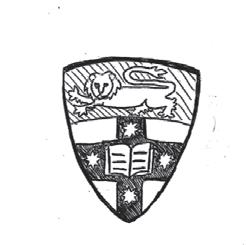

all the revue sketches”, she explained. “Initially, people struggled in trusting this new direction”, she said, “but the reception of the show was great.”
Walder recalled that the USyd Revue in 2018 had a more comical bent due to the comedy background of the hired professional director. 20172019 were the only years where USyd Revue fused the professional and the student theatre world by employing a professional, external director. Revues past were entirely student-run as they are today. According to Walder, the semi-professional environment sometimes wrought chaos and misunderstandings, as professionals and students approach theatre and its commitments quite differently. Ultimately, she spoke positively of the experience and remarked how its semi-professional environment offered cast members a different experience to the typical revue.
2020’s USyd Revue director was meant to be Diana Reid, but the show was cancelled in the wake of COVID. Since campus has been re-flooded with students, there has been little news of a USyd Revue return. Although the decline of revue participation is attributable to COVID, our lukewarm
the bowels of student services, activism and journalism
Victoria Gillespie heads underground.
Below the City Road footbridge, nestled underground in the basement floor of the Wentworth Building, lies one of the most important institutions on campus: the Students’ Representative Council (SRC). Known for its elections and forgotten for its important services, the SRC has been here since before the reception staff can remember.
The SRC provides loans, free caseworker help, legal advice, amongst other services like referrals, and consultations to undergraduate students. While many struggle to conceptualise the organisation’s breadth or impact, it is the bastion of student services.
According to Publications Manager Mickie Quick, the SRC was previously located in the Brendan McCallum building and moved here around the 1980s. Despite recurring promises to move the office and plans of demolition, the SRC remains within these walls, untouched by natural-light. Only one working service elevator remains, a sign the university does intend to proceed with their promises. Honi Soit contributor from the 1960s Rowan Cahill commented, “it was like visiting the underworld of a lost planet in an old science fiction movie!”

While the Wentworth Building is property of the University of Sydney Union (USU) it’s unclear whether the SRC pays some sort of rent. Most problematically, the
feelings towards their endangerment and extinction is a far cry from USyd’s devout revue past. In 2015, all but one Engineering Revue cast member threw in the towel the day before opening night. Rather than let this rambunctious revue fall to the wayside, a ragtag bunch of USyd Revue members and other Revue directors stepped in, and fashioned a revue in 96 hours.
One whispering of a return for USyd revue comes in the form of an ad hoc group chat devised in late 2020, named University of Sydney (revue) Union. Ex-Revue directors, 2020 USyd Revue participants and Conservatorium of Music students planned to revive the revue without USU backing. However, thrown into another lockdown, this chat’s dreams never saw the light of day, and many of its members have since graduated.
Must we be the change we wish to see for a ‘Best Of’ Revue? Is it worth dusting off the cobwebs? Will it be a matter of the USU deciding, since they hold all the cards (and funding), or a dedicated team of actors reviving a lost relic? After all, the show must go on…

University and the USU have failed to respond to the ‘Wentworth Must Fall’ campaign to rename the Wentworth Building. A central figure in socalled Sydney’s formation, William Wentworth imported slaves, aided the dispossession, enslavement and massacres of First Nations peoples. The campaign continues and awaits action from student politicians.
So, what lies within the fluorescent hallways?
SRC Caseworker Offices: The SRC does much regarding casework, student legal help and the functioning of things on campus that one wouldn’t give a second glance. Caseworkers provide assistance on a range of matters including “The SRC does much regarding casework, student legal help and the functioning of things on campus that one wouldn’t give a second glance. Caseworkers provide assistance on a range of matters including “academic rights & appeals, special consideration
& special arrangements, HECS & fee refunds, academic misconduct & dishonesty allegations, show cause & exclusion, Centrelink, financial issues, tenancy & accommodation, and harassment & discrimination”. While the office used to be open to drop-ins and phone consultations, the influx of requests over the Covid years forced consultations onto only zoom and phone calls. This continues. Harrison Brennan recalls that around the midpoint of last year, the caseworkers reached annual average load.
SRC Solicitor Offices: SRC legal services are free and cover a variety of issues, including “police & court matters, traffic, transport offences and fines, immigration law & visas, employment law, consumer rights, tribunal matters, and more.”
SRC President Office: The SRC President oversees the executive function of the union, fielding funding requests, and engages with the collectives and Academic Board on issues related to students. Used to be
home to a famed couch...
Gosper Meeting Room: Adorned with past Honi covers, and filled with welcome week bags, the room is a multi-use space named after first ever SRC President in 1930.
Sam Langford Office: Where the Honi editors spend their long Sundays laying up the paper. The office is commemoratively named after the late Sam Langford, a genius editor from 2016.
Ish Varlin Room: Room for the office bearers, renamed after the late Ishtiaq Varlin — long-time trade union and environmental activist — in 2022. The office bearers occupy a variety of roles, primarily convening autonomous and non-autonomous activist collectives and creating publications. The room is littered with paint, protest banners, signs and flyers.
Valerie Chidiac goes to the cinema to watch television. Mild spoilers ahead.
It was pitched as “The Sopranos set in a mosque”, but now is touted as “Succession in a mosque”. House of Gods is an ABC TV show which captures the livelihoods of an IraqiAustralian family tempted by power and influence after their father, Sheikh Muhammad Al Hammedi (Kamel El Basha), is elected Head Cleric at The Messenger mosque in Western Sydney.
The show was created by Osamah Sami and Shahin Shafaei, developed by Blake Ayshford, and has a writers room consisting of Sami, Ayshford, Shafaei and Sarah Bassiuoni. It is clear that the show is by Arabs, starring Arabs, but for everyone.
Isa (Osamah Sami) is the adopted son of Sheikh Muhammad, who has envisioned a more hands-on and reformed style of leadership. However, this does not escape scrutiny, especially by rival Sheikh Shaaker (played by the late Simon El Rahi) and those standing behind him.
Directed by Fadia Abboud, the sixepisode series boasts an impressive cast and also features Antoniette Lattouf in her debut acting role as a radio host, where she exposes the inciting incident: a woman on the street kisses Sheikh Muhammad on the cheek, thereby setting a chain of events that will influence future interactions between mosque leaders, and that of the local Muslim community.
For many viewers, ‘the kiss’ may seem innocuous, but when you see it in context, it cannot be separated from the undercurrent of racism and ‘othering’ of those who express their beliefs in their appearance and behaviour. The religious and cultural norms dictating the interactions of men and women are portrayed to be understood by all, not just Arab or Muslim audiences. Sheikh Muhammad stands his ground, having known he has done nothing wrong, but is forced to play the long-term political game to ensure his position is safeguarded.
Isa — nicknamed the “fresh prince of Fairfield” — becomes preoccupied with the financial side of religion and expanding his pre-existing business. At one point, he is told that “it looks like we are running a bank, not a mosque.” His older sister, Batul (Maia Abbas), who has just come back from Iraq, has ambitions to be influential in the community, and occupy the position of Vice-President of the mosque. Their younger sister, Hind (Safia Arain), wants a path of her own, without jeopardising her family’s leadership roles or putting her own dreams on hold.
Jamileh (Priscilla Doueihy) is married but cannot exercise her agency because she believes that since she chose this path, she is not entitled to complain about it. While Batul does not fully elaborate on her experience, we know she is escaping marital

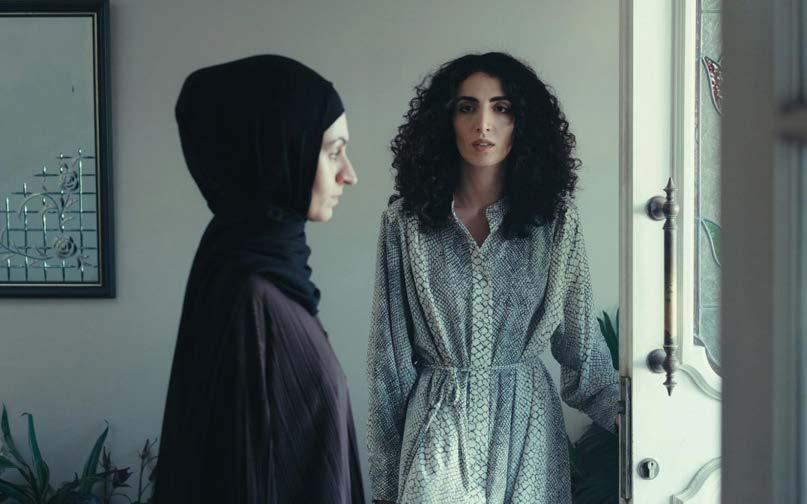
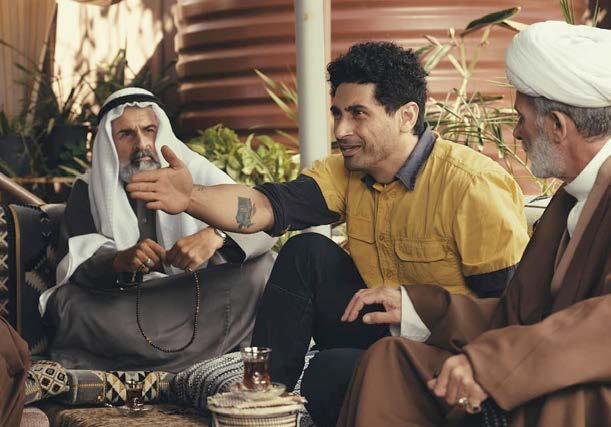
problems with her husband in Iraq.
From the first two episodes alone, the series commits to its goal of holding a microscope to those who politicise religion, whether that be leaders or those on the periphery. Enforced secularism and pluralism are carefully interrogated, in light of Australia being labelled and praised as a multicultural entity. One example that best encapsulates this is that people are more likely to “accept a kids-only area but not a women’sonly swim hour.”
The standout performer without a question is Palestinian actor Kamel El Basha, who previously won the Volpi Cup for Best Actor at the 2017 Venice Film Festival for his performance in the Oscar-nominated Lebanese film, The Insult. He brings a grounded quality to his role as a Sheikh and father. He is non-judgmental, patient, funny, kind and strong, all the qualities Arab men are stereotypically robbed of within storytelling — and sometimes, in real life.
As such, Uncle Samir’s (Majid Shokor) character arc is very intriguing, as he identifies as someone who practices no faith. Samir was in Saddam Hussein’s prison along with Sheikh Muhammad, and as a result, is haunted by the memories.
If you are also looking for comedy, House of Gods has plenty to offer. When one of the female characters said that her ex-boyfriend “Trevor
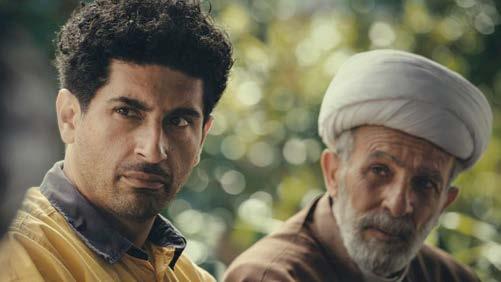
tried to learn Arabic for me”, all women in the audience could not keep it together. Women of colour always do deflect with humour! It is minor quips like this which reinforce the power of representation, which is in the details and not just the overall picture.
Personally, I felt seen when I heard the line: “In some ways life was better there [Iraq], but in others it is here”. As an immigrant, born overseas, and growing up in an Arabic-speaking household, it often feels like two opposite worlds that refuse to intersect with one another. You become trained to notice the pros and cons of each place, especially when people ask you, “which country is better?”, “where do you prefer to live?” and “where do you want to live when you grow up?”. How do you reconcile both pieces of you? I don’t have an answer, and there may be no correct answer. We can still ponder this, and House of Gods is doing just that.
After the screening ended, Sara Mansour from the Bankstown Poetry Slam conducted a question and answer session with the cast and crew.
The timing of the show was inseparable from the genocide in Palestine, and war in Sudan, as it is “humanising Arabs when Arabs are being dehumanised.” The creators clarified that while the story is not necessarily about Palestine, it can help counteract this dehumanisation because context is not separate to art.
Sami also emphasised that “we’re not portraying sinning Muslims, we are portraying Muslims”, in response to the black-and-white incarnation we typically see: terrorists or pious worshippers.
The female cast members noted that “irrespective of religion, women who don’t toe the line have it harder” and through these characters, they were able to develop beyond what we might designate as limitations of culture.
Throughout the episodes, Arabic is seamlessly integrated within the dialogue, and is not relegated to the usual “habibi”, “yalla”, “walla” and “aywa”. It was revealed that the use of Arabic allowed for the delineation of particular conversations and relationships; the brothers and community elders speak Arabic, whereas the children respond in English.
Most importantly, the show did not centre an outsider as the audience’s way into the community. Instead, it focused on casting Arab, Iraqi or Muslim actors to facilitate authenticity in the setting and character multidimensionality.
And so, when co-creator/writer/ executive producer/actor—aka the Jamal of all trades—Sami urged the audience to promote the show via word-of-mouth, I heeded the call, not only because he asked for it, but because I believe you should tune in too.
Imogen Sabey spills the chai.
I am not a coffee person. For me, heaven is a chai latte: hot, fragrant, and a perfect balance of sweetness and spice. It melds the fuzzy winter atmosphere with a more complex flavour profile than hot chocolate, containing caffeine but not degrading itself to astringency. Thus, the title Chai Time at Cinnamon Gardens conjures a cosy, warm environment set in the titular nursing home, Cinnamon Gardens.
a refuge for themselves and other Sri Lankan immigrants from war’s atrocities. At the beginning of the book, it is revealed that Zakhir, her husband, has disappeared, presumed dead. In his absence, Maya resigns as the owner of the home and becomes a resident herself, leaving her daughter Anji and her husband Nathan to run the operation in her stead.
the bureaucratic racism perpetuated by his colleagues in the silent-butdeadly stinkfest of Australian politics. Everyone is white, nepotism abounds, and it all hits a little too close to home. The magnifying glass on Sydney politicians was just as greasy and execrable as I expected.




Alas! It was not to be. Shankari Chandran’s novel is superbly written, but cosy it is not. The similarly inviting cover, featuring plants, tea, books and a typewriter (I felt personally targeted) has hoodwinked many a reader into perusing the pages of this oh-soinviting book. But the gentle beauty of Cinnamon Gardens hides the bitter and mournful experiences of those who live and work within it, who have endured hatred, racism and deepseated intolerance.


The story weaves the residents’ past memories of their Sri Lankan homeland, and Sydney, where racism persists and the remnants of colonialism remains in an empty plinth and the missing statue of Captain Cook.
The plot spans decades and generations, recalling the civil war in Sri Lanka and the immigrant struggle which has only recently been given the attention it deserves in the Australian publishing industry. Cinnamon Gardens was created by Maya and Zahkir in the Sydney suburb of Westgrove, in the 1980s. It acts as
Zoe Le Marinel reviews.
In the basement theatre of the Erskineville Hotel is a play well worth seeing, newly developed through Fruit Box Theatre’s RIPE program. Back to Birdy is immersive, gentle on the senses, and while not completely polished, accomplishes more than I’ve come to expect from much larger-scale productions.
The play follows the course of a single night of catching up between two friends, Emily (Gemma Dart) and Warren (Hayden Moon), who have much more to say to each other than they thought. The play moves between their present and their past, and the two friends freely interact with their younger selves. The audience are seated at restaurant tables in the small space, and in the centre of us all, elevated on bar stools, are the two old friends — an island floating in the sea of our gaze. It was very eerie to watch the two characters discuss their feelings of isolation and pressure while dozens of eyes stare them down from other tables. I have rarely felt so aware of myself as an audience member.
Many of the characters experience racism in different ways, from microaggressions to physical assaults. However, Maya manipulates the racist system to her advantage. She has literary ambitions, and sends a manuscript based on her civil war experiences to nine Sydney publishers, to no avail. Her rejections are based on her book being “too ethnic.” So Maya rebrands herself as Sarah Byrnes and writes about a straight white character called Clementine Kelly, publishing eleven bestselling books and gaining ardent devotion from the Country Women’s Association. All the shots taken at the CWA were unexpected but extremely funny. Chandran wasn’t just criticising the CWA for being overly enamoured with characters that looked like them, but at the NSW publishing industry that selectively chooses stories that might appeal to a mythicised, homogeneous Australian entity.
A prominent plotline concerned Gareth, a friend of Anji and the husband of Nikki. Nikki is Sri Lankan and works at the nursing home, so Gareth has a foot in Sri Lankan culture whilst simultaneously dealing with
I’m known for loving all theatre, but it’s rare that I recommend anything to my friends like I have Back to Birdy. This play is a powerful and realistic depiction of not just growing up gay but of getting older gay. The haunting sadness of having infinitely more knowledge than you once had — and the constant burning wish that you could go back in time and be a better friend, a better partner, a better confidant.
The first fifteen minutes of the play were, I’ll be frank, gratingly awkward. The actors felt like they were shaking off nerves, we had strange pauses that felt unnatural; we all shifted in our seats. But as the ice broke, Emily and Warren started to really interrogate and recontextualize each other’s memories, going off at each other, defending themselves; being vulnerable. Then the room filled with rich reality. The visceral nature of memory played out amidst the unusual performance space in the best possible way; my compliments go to a happy union of subject material and staging.
The discussion of the transphobia Warren has endured, and continues to endure, struck a particular chord with me. No other production I know
Another major plotline revolves around Captain Cook’s statue, which was pulled down by Anji’s father during her childhood, when he saw her and her brother casually saluting it. Her memory of this incident delivers a fascinating insight into the way that children interact with the grim and bloody side of Australian history: “CJ Cook was a criminal who was never convicted for his unspecified but heinous crimes.”
As such Anji’s defence of her father feels like a protest against the racist, colonial narratives that have dominated her life both in Sri Lanka and in this country. “In Australia, we are taught the mythology of colonisation… Captain Cook represents that mythology, that great lie that all colonisers tell themselves and the colonised. Appa said that Cook had no place in the pantheon of heroes or in our home. That’s why he took the statue down… why the statue will stay down.” Anji’s firm and defiant stance is timely and refreshing in the society that Chandran exposes, where racism is embedded within our histories, relationships and interpretations of identity.
It is at this point that the intertwining narratives of colonisation
of has been able to capture the way memories can brand us. Moments and conversations that meant little or nothing to our loved ones are the very same things that we remember and mull over every day of our lives. The sheer exhaustion of it, the mixture of shame and betrayal and fear. The line ‘I hoped you would see me as being the same, but more me…but you looked at me — like I was someone you didn’t know.’ hit me especially hard.
The exceptional handling of the transgender experience is what puts this play above so many, and Hayden Moon’s performance as Warren does a great script justice with gravitas, intelligence, and straightforward sincerity. Angelica Lockyer’s performance as the younger Warren is a heartbreaking, but well-executed reflection of Moon’s older, happier man.
Gemma Dart as Emily had my attention from the first moment, and only got better as the performance leaned into natural, conversational humour and the all-too-relatable clumsy effort to connect. Emily is your lesbian friend from high school who knows nothing about trans people but is for sure trying her best; who
and racism in Sri Lanka and Australia converge. Chandran is doing what few Australian novelists have done; or rather, been permitted to do. Her characters face challenges similar to many Australians whose stories we do not hear. Chandran highlights how important it is to read diverse stories, as literature is a focal point through which we can see society in its simple grace and unvarnished ugliness.
The strongest points of the novel lay in its musing on identity and what it means to be Australian, even when that is undermined by racial profiling and whiteness-as-default. When Chandran engaged with these issues head-on, the ferocity and passion of her voice shone through the characters. The book sprawls over numerous characters, settings and plotlines, but it has a consistently warm-hearted spirit. The parts about the CWA and their love of the Clementine Kelly bodice-rippers were my favourite because it showed a latent racist mindset that was being blatantly duped. However, the way that Chandran deftly dealt with racism in all its shapes and sizes demonstrated palpable proof of her talent.
Racism is the novel’s main concern, stemming from the warring between Sinhalese and Tamil people, the careless disdain of bureaucrats and politicians, physical aggression from bullies on the street, and even from friends. Chandran teaches us to take heart and to forgive wrongdoings, but use stories to immortalise them in memory.
you can’t help but love despite being a little defensive and a little juvenile. Dart nails the charm of an imperfect character, and Chloe Jayne as her younger self adds to the complexity, giving Emily a buried meaner streak that sends the two performances into a feedback loop of personality.
Back to Birdy is as raw a performance as its subject matter. There was occasional odd pacing in the middle, and in my opinion the handling of suicide themes could have been given more weight within the narrative. Sound and lighting (insert names) were a delight and helped forward the narrative, although sound occasionally veered too loud.
Despite these minor flaws, the performance affected me deeply. It got me thinking back over the friendships I’ve lost and gained, damaged and repaired — and the role memory has to play in all of it. Writer Z Bui has given me a lot to mull over with this incredibly potent story — I can’t wait for their next work, and I hope you all go and see this one while you can.
Back to Birdy is playing in the basement at The Imperial Hotel, Erskineville, from February 21 to March 1, 2024.

Hannah Vlies Lawrence goes to the gallery. As a recent break-up-er, the task to review the Sydney College of the Arts Student Society’s (SCASS) show, ‘love Deluxe’, filled me with a certain trepidation. I imagined the exhibition teeming with my peers and their uncomplicated and unconditional embrace of love. The daydream broadened to a room full of couples, connecting the intimacy of the works to their own partnerships. In my mind, the exhibition had become a potion of sorts:a pink hellscape of mutuals devoting their love and then me, the notes app, and my editor Vic.




The exhibition featured current Sydney College of the Arts (SCA) students and “an extended universe of scassophillics” displaying their representations of love. In this “sappy group-sop”, love is explored in all its genres and intricacies, adorning all that enter the exhibition. Works were clustered on the floor, ceiling, and walls. They intercepted conversations and interrupted movement around the space.
Lara-Marie Wilkinson’s ‘like trees’ was nervously stepped around, with hair and shell-like paraphernalia enmeshed in a single bicycle wheel in the centre of the space. It was a delicately-organised cacophony of found items; a demanded invitation to look closer and sit with the tangles and the muck. Jennifer Lara White’s ‘all my words, forgotten in a kiss; venustraphobia,’ whilst hidden behind the main exhibition space, became a
central point of connection between artwork and audience. A ghostly slice of fabric hung in front of a projection coloured by ever-changing visuals casting a shadow on the wall behind and obscuring an easy-viewing of the transcendent sequences. With seats on either side of the projection, loveviewers are forced to walk behind the fabric and throw an even greater shadow to take up the offer of a welcome rest. In white thread stitched on white fabric, Jennifer Lara White writes “do you want to talk about it?”. There was no avoiding it, this love was not to be ignored.
Each artwork was accompanied only by a silver heart container. We wondered if the artist information could be found inside, but we instead found little rolled-up love letters from audience to artist. Whilst the sharing of these divulgences extended the intimacy of the exhibition, I wish I had been able to trace their declarations of love to the artists themselves. Whilst I am a shameless sucker for an artist statement, even a numbered room brochure would’ve assisted to ensure audiences could recognise the artists for the works in front of them. Visibility is certainly integral for emerging creatives and it feels like a loss that artists cannot be immediately recognised for their works.
Along the walls of the central space, love sat side by side. Maeve Jefferies’ hardened silver enmeshment ‘Love me Knot’ next to the alluringly soft (yet
undoubtedly unnerving) snuggling rabbits in abstract (‘psychopomp’) — by Lily Tsuruko Tucker — reiterated the reflexivity of our love — it appears as ours and ours alone — inevitably different and inevitably the same. Bonnie Huang’s bar of soap was suspended in a plastic bag fusing with another loverSoap and becoming one — their newly communal form embellished with a red rose. Juliette Burgess creates a pink calamity of pearl-studded worship — we are called to the altar for submission to this higher (unicorn) spirit.
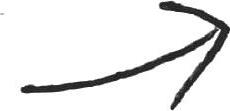
Old flames and new flirts — the attendees spoke to the love exhibited, and the exhibited preached to the lovers. Beyond the romantic tinge of the space, warmth seemed to flow from the pride that each person had for another. In hugs and in kisses. In touches and in smiles. In secrets and in congratulations. We love our flings/flirts/forevers, but we return to our friends. The art scene in Sydney is (terrifyingly) small. Yet, for what it lacks in breadth, it compensates in the respect of displaying your heart on your sleeve to everyone you have ever met.
Artist Lauren Maccoll explains her textile work to be a “nod to the often unseen labour that has shaped my understanding of love.” The people in this room, both exhibitors and visitors, turn up, and show up, to see each other over and over again. A labour of love. Maccoll’s work hangs
Valerie Chidiac boards a solo trip to the Flight Path Theatre.
TW: mental health conditions such as anxiety, depression and post-natal depression, discussions of sexual violence, usage of course language, drug references, depictions of fake blood and flashing lights.
I have a confession to make. I had never been to or knew where Flight Path Theatre was in Marrickville even though I live and breathe the Inner West. However this Valentine’s Day (or night), I rectified this by watching the play Secret Girl Stuff. I did not regret it one bit.
Secret Girl Stuff was a welcome exercise in conveying multiple stories within a short period; it did not let the audience down for one moment. It was brought to life by Cats in the Cupboard Productions — itself a striking name — lead by writer/ director/producer Mikaela Corrigan and producer/cast member Nicholas Pavan, alongside stage manager/sound designer/operator Georgina Moore, and lighting designer Paris Bell.
As the show began I turned my attention to the stereotypical but worthy expressions of girlhood plastered across the walls; Taylor Swift, Katsushika Hokusai’s “Under the Wave off Kanagawa” or “The Great Wave”, Barbie, the franchise whichshall-not-be-named, polaroids, vinyls
and decorative statements galore.


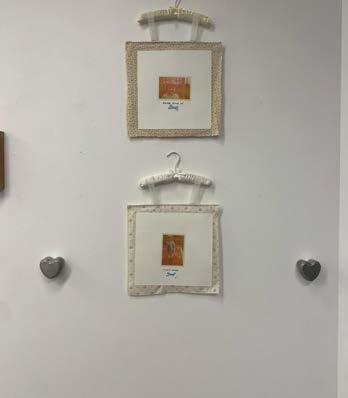
off padded coathangers, adorned with the lyrics of Courtney Barnett’s ‘Sunday Roast’, ‘Some kind of Sweet relief’, which she also has titled the work. I love this exhibition (and I love Courtney Barnett) but mostly I love the adoration those in Backspace held for one another on opening night. To take a page out of Lauren’s book, or perhaps rip her off, I too find myself stuck in the lyrics of ‘Sunday Roast’: “And I know all your stories, but I’ll listen to them again.”
May we continue to turn up, continue to look, continue to listen and continue to love.
love Deluxe:

love Deluxe is on at Backspace Gallery, Level 3, Wentworth Building, University of Sydney. For more information, look at @sca.studentsoc.

The play was an inviting and necessary series of vignettes on the transition from girlhood to womanhood, largely communicated in monologues or dialogues. The subject matter did not hold back; puberty, crippling periods, gay sexual awakenings, the spectrum of sexual experiences, party culture, ‘boys will be boys’ behaviour, gender expectations, unrealistic Reddit forums, peer pressure to ‘send nudes’, endometriosis, pregnancy scares, the scars of motherhood, intergenerational trauma, and fragmented motherdaughter relationships were all tackled. While many of these have been talked about endlessly and are not new concerns, they were depicted with care and nuance, and the lines effectively delivered to the audience in a pleading, and attention-grabbing manner.
Hearing “I’m not scared of what’s growing inside of me, but myself…” led many audience members to nod in affirmation, as some mothers can be reluctant to articulate their fears about the drastic changes to their lives postchildbirth.
The line,“I recycle her mistreatment and use it against myself”, managed to indicate both the beauty and terror of a daughter absorbing her mother’s pain, as well as the self-awareness of knowing
what it’s like to endure second-hand trauma.
Unfortunately, countless women have “had their first time taken away from them”, whilst others contend with the reality of rape culture. At one point, a character recites her shock when given a rape whistle by her own mother.
One of the most memorable vignettes was a tense argument between a couple, impeccably played by Nicholas Pavan and Sophie Persson. Nothing was off-limits; their work-life (im)balance, individual insecurities, and the dwindling intimacy beyond sex — and even then, Persson exclaims, “I lay there while you fuck my body without asking how I feel afterwards.”
Some scenes did lean towards clichéd or mythicised tropes of girlhood, but the overall picture was a series of hyperreal and raw documentations. While I do not relate to the catastrophe that transpired on March 25, 2015, I appreciated how this fervour and subsequent heartbreak were depicted.
It is crucial to note the intentional casting of six women — insert Bob Odenkirk saying “There’s my little women” — Sophie Persson, Lycia Gunawan, Izzy Azzopardi, Madi Hough, Ella Earle, and Angel Samu, whilst Nicholas Pavan was the token male diversity hire. Jokes aside, his judicial
appearances enhanced the ability for the female perspective to take up space, unconditionally.
Persson was a standout amongst the cast due to the demanding roles played but Gunawan was outspoken, Azzopardi fierce, Hough pixie-like, Earle dynamic, and Samu affecting. Pavan was also perfectly cast for the male roles but never stole the spotlight from his colleagues.
The most powerful statement was left for last, with all actors coming out bloodied appearances, to recite a call for justice in the fight to stop violence against women.
“....Last place you want to be, he wants you to stay there.”
“...You can’t remember if you said no.”
“...You’re cheered down an aisle, but booed walking into an abortion clinic.”
Watching the show alongside family and friends coloured my experience as I saw inside jokes as well as real-life experiences being realised and recognised by the audience, adding a personalised touch that is not necessarily present within largerscale productions. And as written by Corrigan, and articulated via her characters, “the rest is herstory.”


join us in building for and participating in this event - check out the flyering information on Students for Palestine on Instagram and Facebook!
Hope we had a great first week of university for 2024. Here what I’ve been up to last week:
In committees this week I’ve raised the serious problems students are facing with finding safe and affordable accommodation as the rental crisis continues. Many students right now are experiencing housing stress, in no way helped by the universities historic approach to housing, namely how they have historically sold-off affordable accommodation on campus, approved extreme price increases at university owned accommodation, and have kept International House in limbo, a building which could house over 200 students.
I attended the Students for Palestine (SFP) open meeting on Tuesday to plan for the upcoming national student strike on Thursday February 29th, and have since been flyering for the rally on Eastern Avenue and at the Scholarship Welcome. ACAR in collaboration with BDS Youth and SFP have also been planning events for Israeli Apartheid Week, so watch this space!
On Wednesday at 2pm student activists and myself headed down to the Families for Palestine Camp For Ceasefire community picket outside of Anthony Albanese’s electoral office in Marrickville. Families for Palestine is looking for people to help man the picket throughout the week. If you are interested in lending a hand, visit their instagram at @familiesforpalestine.
I have been continuing to work with other student unions across NSW on the Fair Fares Now campaign to give international and part-time students access to concession opal cards. If you haven’t yet signed the petition, check out the linktree at @src_usyd to sign!
From Week 2, the SRC will be stalling and flyering on Eastern Avenue every Wednesday at 12pm. If you have any questions, queries or concerns, come visit us in person and grab a handy 2024 wall-planner if you haven’t yet!
Grace Street & Shovan Bhattarai
This week is our National Day of Action for Palestine. This Thursday, 29 February, we will be meeting at 1pm on Eastern Avenue before marching to meet other students and the community at Town Hall at 2pm. As the genocide of Palestinians and attack on Gaza intensifies, it is as important as ever to voice our demands for a ceasefire, reinstation of UNRWA funding, lift the siege on Gaza, end the occupation of the West Bank, demand Australia cut ties with Israel, and for a free Palestine. We want all students to
In Welcome Week we spoke to students about the upcoming rally for Palestine and had lots of students, staff and visitors sign our banner endorsing the Student Strike for Palestine. It was great to talk to new and returning students about their studies, education organising, and campaigns like Books not Bombs - Thales off Campus, and Students Against Placement Poverty.
We are gearing up to receive the information back from the Australian Universities Accord, which we will be scouring as you read this report now. We don’t expect much from this neoliberal Labor inquiry involving the government, various ambiguous ‘stakeholders’ and uni management. In the face of USyd management having already announced this year Studies of Religion and Writing Studies no longer being offered as majors, we will continue in our fight against the corporatisation of higher education institutions, for better staff pay and working conditions, and for free, accessible education.
Check out our annual EAG publication ‘Counter Course’ available online or in the SRC handbooks from Welcome Week to read pieces by our members on anti-protest law, research funding, USyd’s radical history, and student movements around the world. We extend our solidarity to students in Greece protesting against the introduction of private universities and to everyone around the world fighting for their governments, education institutions, and more to cut ties with Israel in line with the global BDS movement.
Eliza Crossley & Rand Khatib
Wow what a busy time! Over the summer WoCo worked on the Abolish the Colleges campaign which was launched with a rally hosted by WoCo and Quac against sexual violence.
We have also been flyering for the campaign with Jenny Leong and have launched a website to be operated by a couple feminist groups and the Greens called Abolishthecolleges.org where you can pledge your support. We have designed a survey to be put out to get student input which will be launched shortly.
WoCo also collaborated with ACAR and First Nations Collective and had a presence at the Invasion Day stall handing out water and snacks. Thanks to everyone who helped out.
With the editorial team we also made Growing Strong! The themes for the edition are decolonial feminism and abolishing the colleges. It’s 32 pages, with 15 articles, an editorial team of 11 and 7 artists. Thanks for everyone who helped out, and a special
shout out to the SASH obs for your hard work.
If you haven’t come to a WoCo meeting yet this year but would like to, please come! We’ve got a little bit of merch left and plenty of Growing Strongs. We’re reclaiming the Manning Women’s room so find us there!
Join us on facebook @USYD WOCO 2024
Come along:
• Colleges Forum - Afternoon of Tuesday the 5th of March (not autonomous)
• SASH OB film screening, The Silences of the Palace - March 7th at 6pm Old Geology lecture theatre (not autonomous)
In love and rage, Eliza & Rand
Gerard Buttigieg, Jasmine Al-Rawi, Julius Wittforth & Ellie Robertson
The Welfare Officers had a great O-week!
We joined others in promoting the Palestine rally for next Thursday, getting students involved and aware of the SRC’s activism coming into the new year, and getting people involved in the Welfare Action Group for our ongoing campaigns for housing, Palestine, concession opal cards for international students, drug reform and more!
We hope to continue agitating and building our movement and the Welfare collective for a big year of student activism at Sydney University.
Kejun Liu, Zhongxuan Jiang, Fengxuan Liu & Astrid Xue
In February, we have accomplished several tasks. Firstly, we initiated preparations for the welcome party with Monica. Secondly, during the orientation week, we have been gathering signatures for a petition advocating for Opal card concessions for international students. We have already collected 2000 signatures during this period. Lastly, we have secured the party venue (Hermann’s Bar) and scheduled the event for March 8th.
Looking ahead to March, our objectives include continuing to collect signatures until March 7th and hosting the welcome party on March 8th.
Ellie Robertson, Martha Barlow, Georgia Zhang & Olivia Lee

2024 is already shaping up to be a big year for SASH activism. During welcome week we spent 3 fantastic days at the Women’s Collective stall chatting to new and returning students about the Abolish the Colleges campaign. We are so excited that the Greens are bringing legislation to parliament this year to change the Colleges’ structurally independent legal status, and we are currently focused on getting as much input as possible from the community to create that legislation. We also attended and spoke at the annual welcome week End Sexual Violence on Campus rally. This was a huge success, and garnered lots of attention as we marched down Eastern Avenue. Positive or negative attention, we can’t entirely say – but we certainly got people talking.
Over welcome week we also handed out hundreds of copies of Growing Strong, WoCo’s annual magazine. As well as writing and editing, the SASH officers put together the resources and responding to disclosure section. This section details how students can make complaints and disclosures to the university, as well as providing a details of organisations that help with emergency counselling, housing and support. Whilst the reporting system is far from perfect, we hope that this section sheds some light onto resources available for victim-survivors.
In other areas, we endorse and will be attending the National Student Strike for Palestine on Thursday 29th February. Join us at 1pm in the quad to show your solidarity and protest our government’s complicity in the genocide in Gaza.
The final thing to shout out is our film screening! Join us on Thursday 7th March at 6pm in the Wallace Theatre for a screening and discussion of The Silences of the Palace, a great Tunisian Feminist film. Snacks will of course be provided. See you there!
- Martha, Olivia, Ellie and Georgia
There are lots of advertisements showing cheaper ways to pay your international student fees. Some will even do smaller transactions with a refund on the exchange rate, for bills like mobile phone or internet, rental payments, or even your SSAF. Unfortunately, they are ALL scams. ALL OF THEM.
Unfortunately, they are ALL scams.
ALL OF THEM.
Dear Abe,
I am embarrassed to say that I am still a virgin, and I don’t know much about sex or sexual health. My boyfriend has been very patient, but I think I will need to have sex with him soon or he will leave me. I feel scared and I don’t know what to do.
Please help me.
Embarrassed
Dear Embarrassed,
I am sorry to hear that you feel embarrassed about being a virgin. Media and friends can put ridiculous pressure on us to conform to standards we don’t all subscribe to. You should have as much consensual, safe, and fun sex
They will do the smaller transactions for you without a problem to build your confidence in them, to encourage you to pay your fees to them. They will even issue you a fake receipt, so you won’t know that you have been scammed until you are at risk of being unenrolled from uni. Don’t risk it. Pay your fees to the University through the official channels.
For more information about these scams click here: scamwatch.gov.au
Dear Abe, I’ve applied for Centrelink Youth Allowance, but they said I can’t have it because my parents earn too much money. My parents don’t give me any money, so I think I should be able to get the payment. What should I do?
Independent
Dear Independent, Unfortunately, Centrelink don’t care about your actual circumstances. They will only consider you independent if you:
• are 22 years or older

• have special circumstances (e.g., you’re an orphan, or parents are in prison)
• have worked an average of 30 hours a week
• are married, or in a marriage-like relationship
You might be eligible for a Low Income Health Care Card that won’t give you an income, but may help with any health costs you have. Talk to the Uni’s Financial Support Services to see what they can offer you.
For more details about Centrelink go to the SRC’s Caseworker Help page: bit.ly/3XV5b5n
Thanks,
Abe
If you need help from SRC Caseworker start an enquiry via our Caseworker Contact Form: bit.ly/3YxvDUf
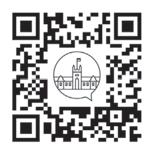

as you like. If that means none, then that is what you should do. If your boyfriend does not like that, you do not have to be in a relationship with him. Also consider that not all relationships have to be monogamous, and this might be something you could discuss with him.
The Health Direct website (healthdirect.gov.au/safe-sex) has information on sexual health and safe sex, and there is specific information for international students through the NSW Health website (internationalstudents. health. nsw.gov.au).
You can also get free telephone advice on 1800 451 624.
Abe
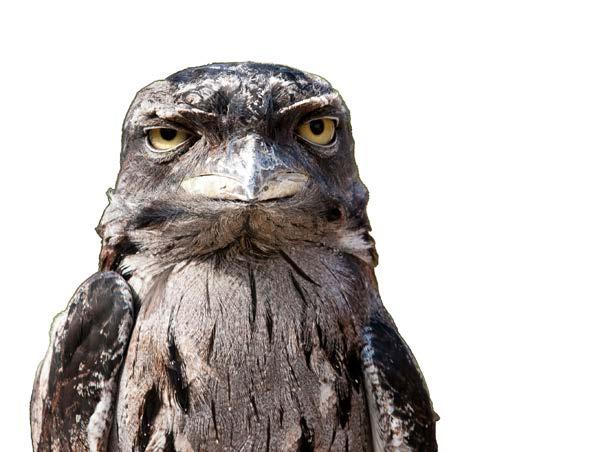











1. The nickname for USyd used on all open day tours is Oxbridge. Which two universities inspire this nickname?
2. What was the exact date that the Jacaranda Tree in the Quadrangle died?
3. Which three prime ministers were involved — in any shape or form — in the Political Economy academic dispute in the 1970s-80s?
4. ______ Politics and Foreign Policy will not be offered in Semester 2.
5. Whose 2022 article called for the re-opening of the Fisher Library terrace?
6. The only fast food franchise on campus is…
7. The notorious place for LinkedIn profile photos is…
8. What is the slogan on the Michael Spence plaque on the ground of the Science Road entrance to the Quadrangle?
9. Which 2011 movie filmed scenes on Camperdown campus and was in competition for a Palme D’or? Hint: The director is an USyd alumni and ex-Honi editor (1989).
10. The Graffiti Tunnel was birthed from which student protest movement?
by Julia Leigh. 11. The Anti-Vietnam war movement.
Answers: 1. Oxford and Cambridge. 2. October 28, 2016 (RIP). 3.Tony Abbott, Anthony Albanese and Malcolm Turnbull. 4. American. 5. Roisin 6. Murph. 7. Subway. 8. Abercrombie (ABS), more -specifi cally in front of the spiral staircase. 9. “We must learn to disagree well”. 10. Sleeping Beauty, directed

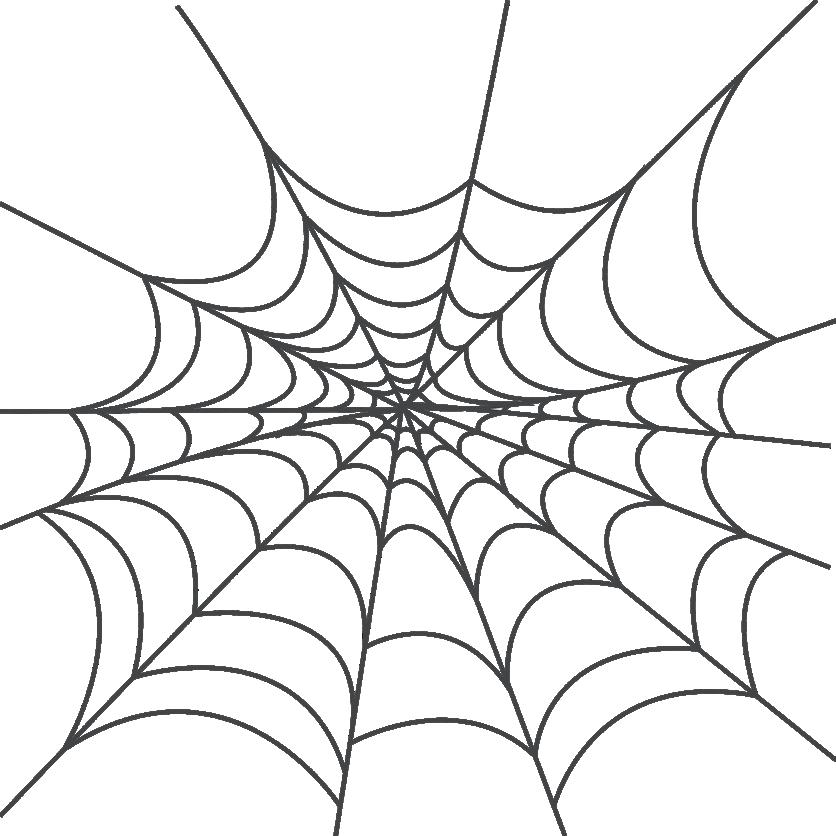


‘Squalor in S.R.C. Office’ Honi Soit, March 21, 1946. Some things never change...
Down
1. “Save it for the honeymoon!”
2. Fares alright
Crossword:
Across
1. Word after Gossip or Gone
5.
11.
14.
16.
17.
18.
20.
21.
goof
22. African language group with roughly 350 million speakers
23. They're often cut in breakups
24. Like some stick-on eyes
26. Some hospital areas, in brief
28. Classroom response to one's name
29. Udon topping
30. Acclaim
32. University street that runs horizontally through
both campus and this puzzle's grid
35. Alto clef readers, in orchestras
36. X, Y, or Z, e.g.
38. Union member, in a sense
41. Abbr. in state school email adresses
42. Topmost symbols, in heraldry
44. Qatari monarch
45. Giveaways at a casino
47. Closed-___ (workwear requirement, often)
48. Mount ___, largest city in the Queensland outback
49. European country whose flag bears 8 stars and a yellow triangle
51. Rebel
52. Like most residents of Hamtramck, Michigan (the only US city for which this is true)
54. Surges in votes, say
56. Victorian shopping center like Sydney's "The Strand"
57. Vanilla product often used sparingly
58. Bounce back, as a shop from COVID
59. Rap artist behind the 2024 album "2093"
3. First South American city to host the Olympics, in brief
4. Elbow room
5. “___ & Woodley”, 90’s Australian sitcom
6. Particle whose name comes from the ancient Greek for “uncuttable”
7. Man’s nickname that drops -vin
8. “___ Nights”, 1997 Paul Thomas Anderson film
9. Slowcore band behind the 1998 album “Stratosphere”
10. Chilled out
11. Pertain to
12. Be all smiles
13. University street that runs vertically through both campus and this puzzle’s grid
15. Video file format
19. Hairstyle-protecting headscarves
22. Russian crepe
23. Cancellation, so to speak
25. More solemn
27. Title awarded to OBE recipients
30. “A Study in Pink” for Sherlock, and “Northwest Passage” for Twin Peaks, e.g.
31. Takes off
33. Egg drink in some holiday traditions
34. Clear-cut
37. One in a classic comedy trio
38. German city home to the Bauhaus school
39. “Without a doubt”
40. Shit-hitting-fan scenario
42. Upmarket
43. Music festival events
46. Ship sinkers, when loose, it’s said
49. Endure
50. Harbinger
51. Dance-pop singer Sawayama
53. One of three in a typical Mariokart race
55. ___ hours (early morning)



Ghost of Margaret Thatcher takes quick break from HELL to complain to Always Balanced Coverage about “weaponised incontinence” on her grave.

This week:
Unisex Toilet c. 2013


Spotted: First Male Victim of Misogyny Kept
Looking Back At A Female Who Was Walking Home Behind Him At Night With Earphones Plugged In
IVF Embryo Has More Rights Than You, Me and Taylor Swift Combined
Plant-Based
Lesbians Refuse To Engage With
'I am doing it for the plot' says famished Russian child in Tolstoy novel
Leftist guy who is into cricket, auspol, footy, beers, and pokies definitely not a nationalist though.
Which little lesbian intern said this –Brad Banducci or Renée Rapp?
“I’ve been going absolutely off in every single interview lately, so now I have to do 40 hours of court-ordered media training.”
Answer: Renée, but also applicable to Brad.
The shock liquidation of Oporto Newtown has dismayed chillimayo heads Sydney-wide.
“Where will I piss on the floor after my gig at the Enmore theatre?!” cried one dismayed Bondi-Burg enjoyer.
The Oporto menu has weathered many suspicious changes latey, ostensibly fresher and doused in less oil.
“The trouble started when they added the halloumi and avo bowl to the menu” one Oporto truther said. “Now they have a vegan bowl, a bondi bowl, and kale salad. I think everyone is switching to Frangos.”
Rumours emerged about what will take the place of the Opulent Oporto.
Always Balanced Coverage has received a tip revealing that the Marly 2 is the menancing monarch set to usurp the Oporto Oligarchs.
